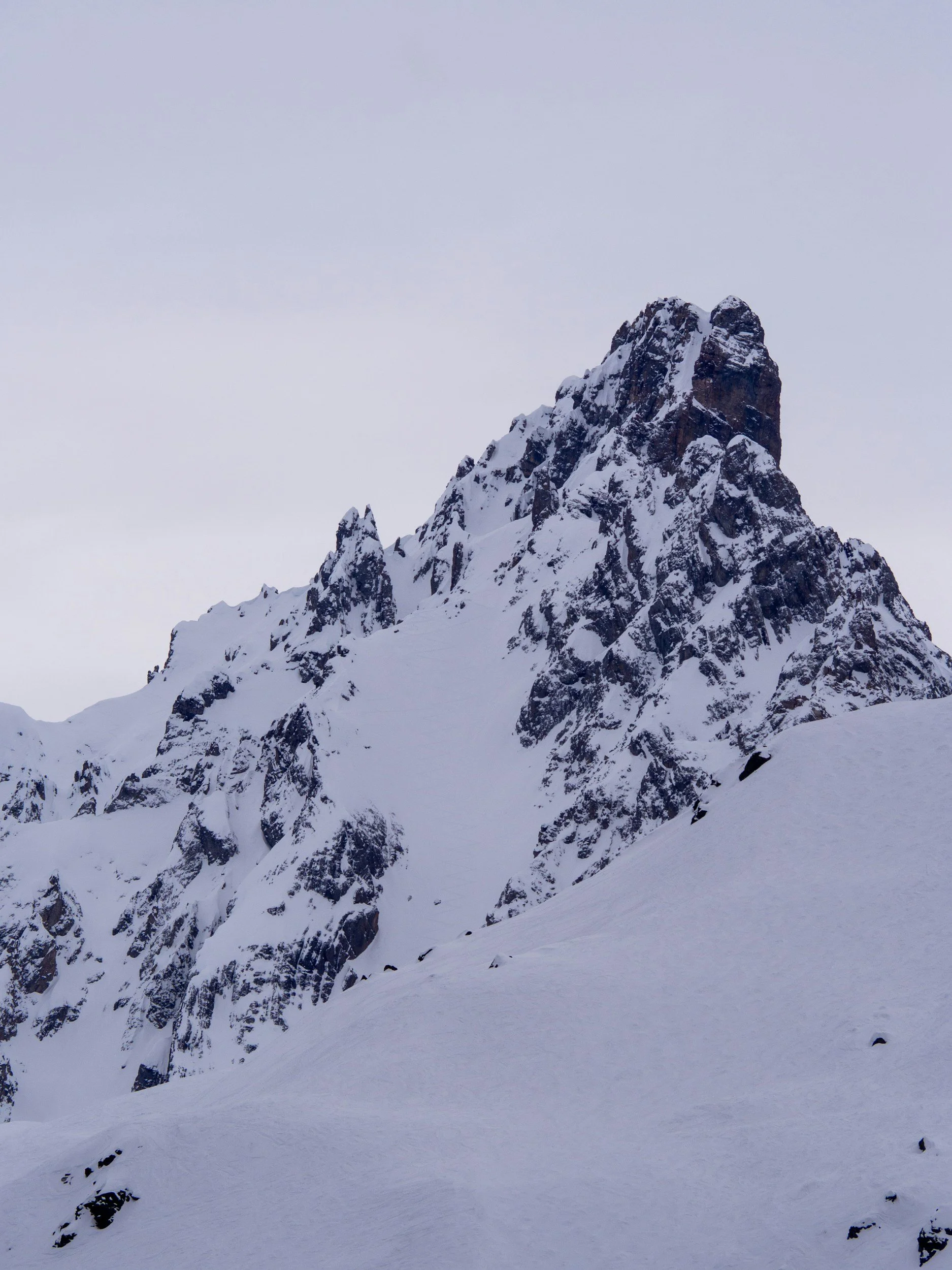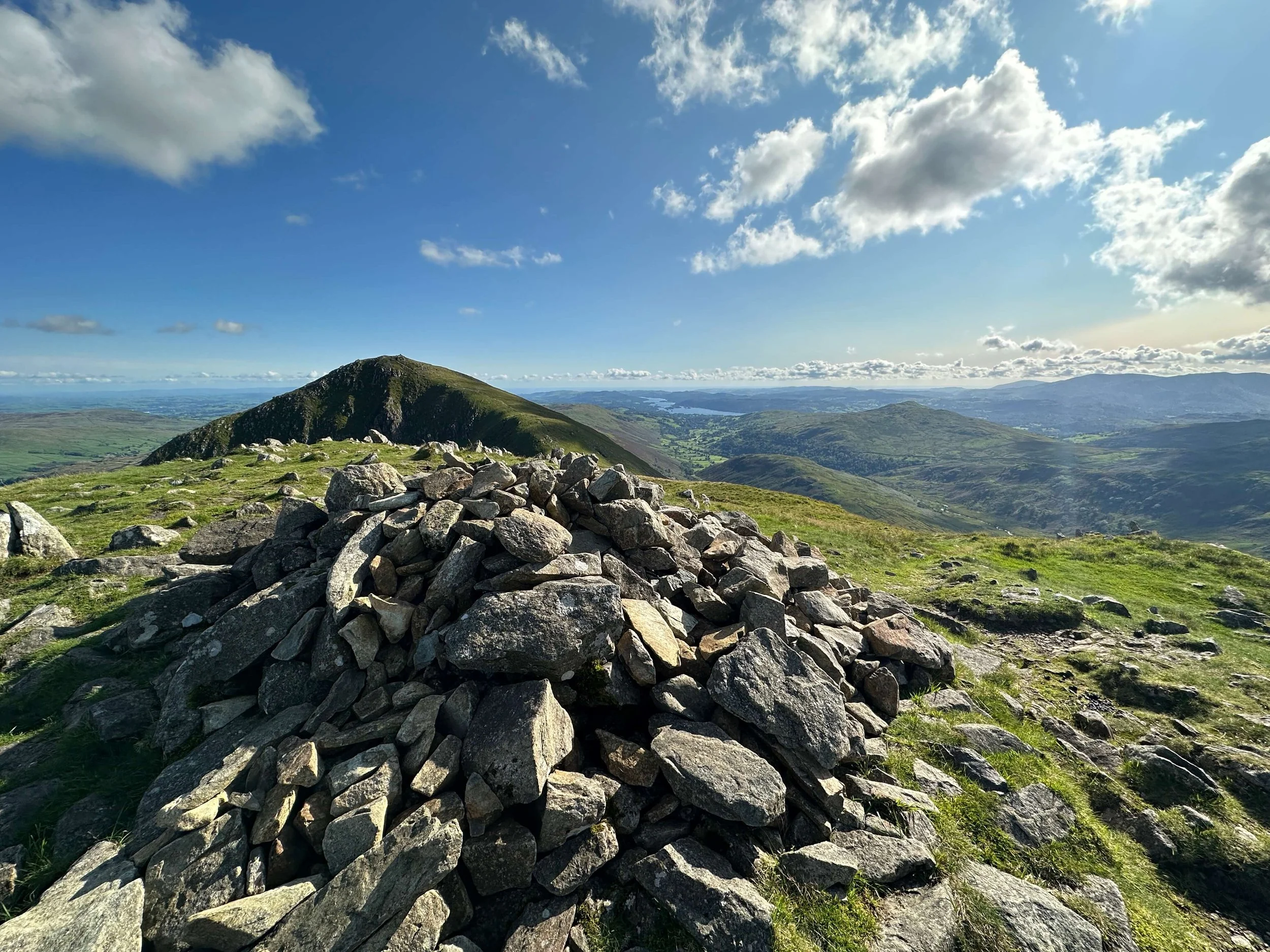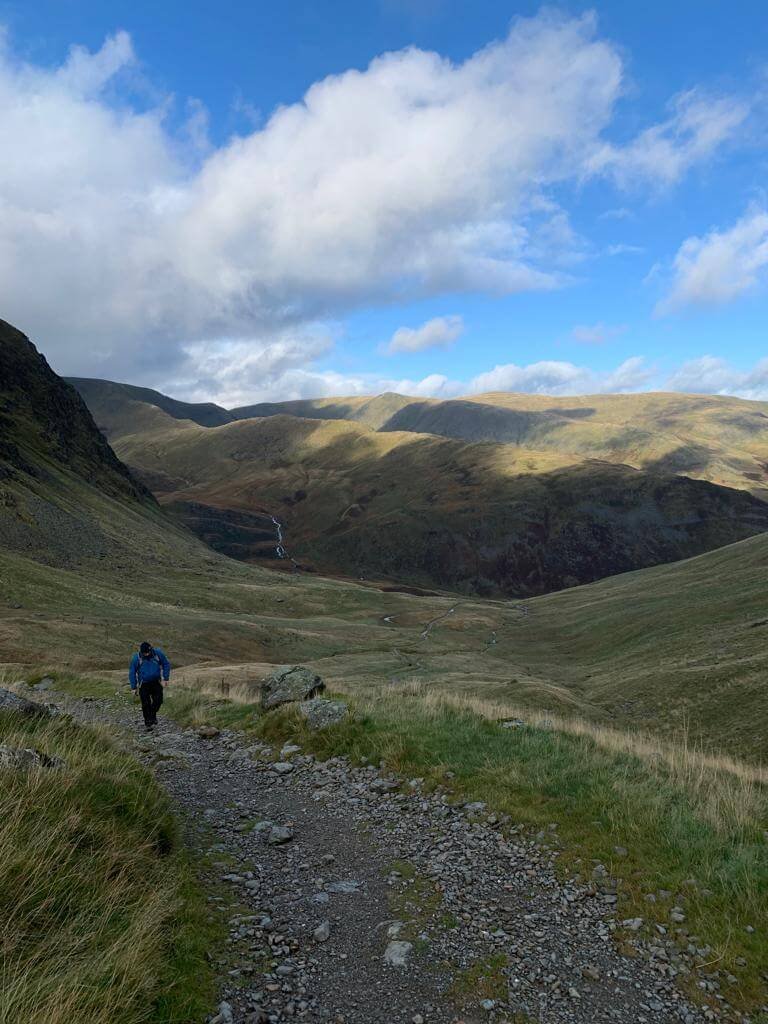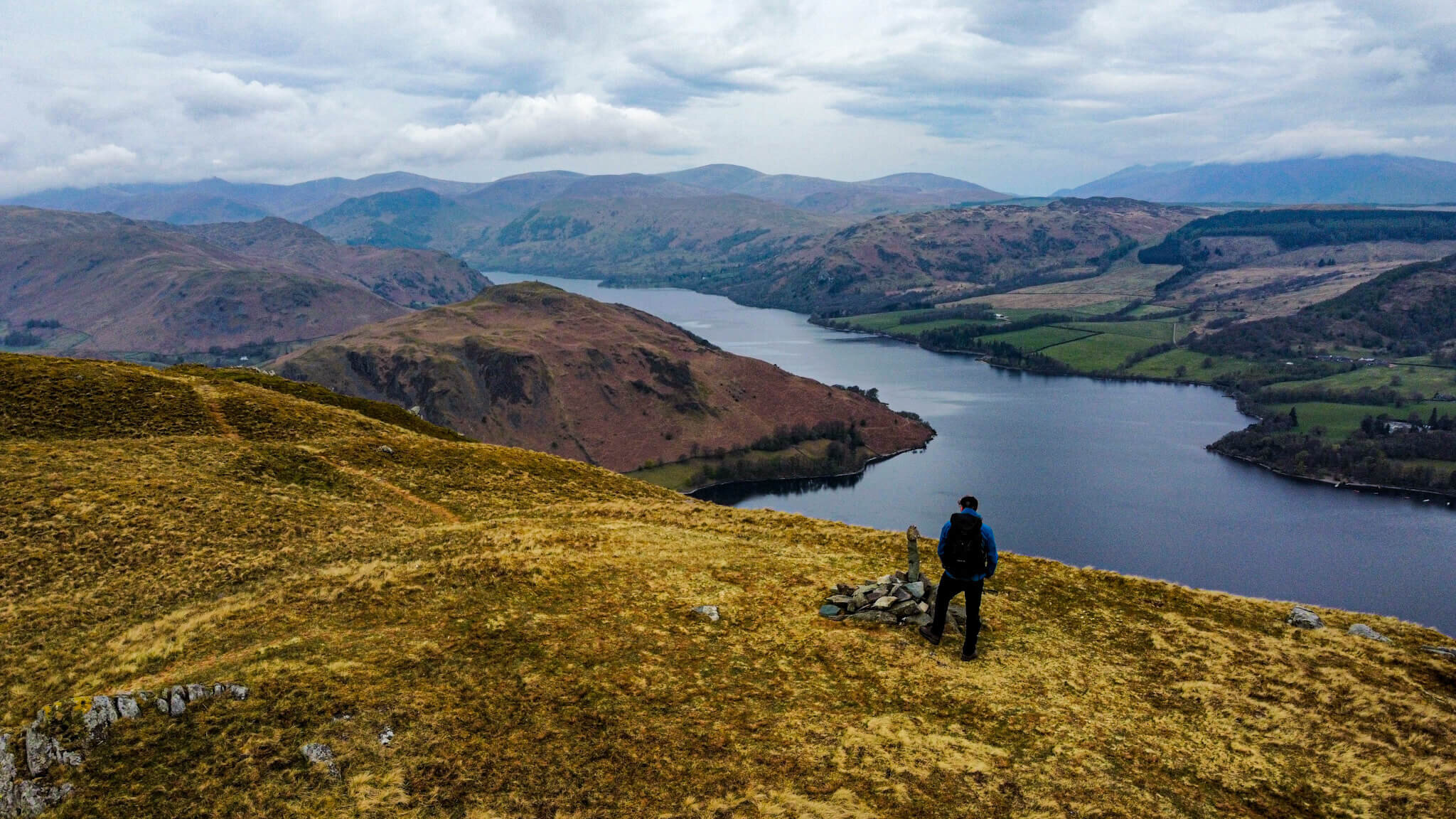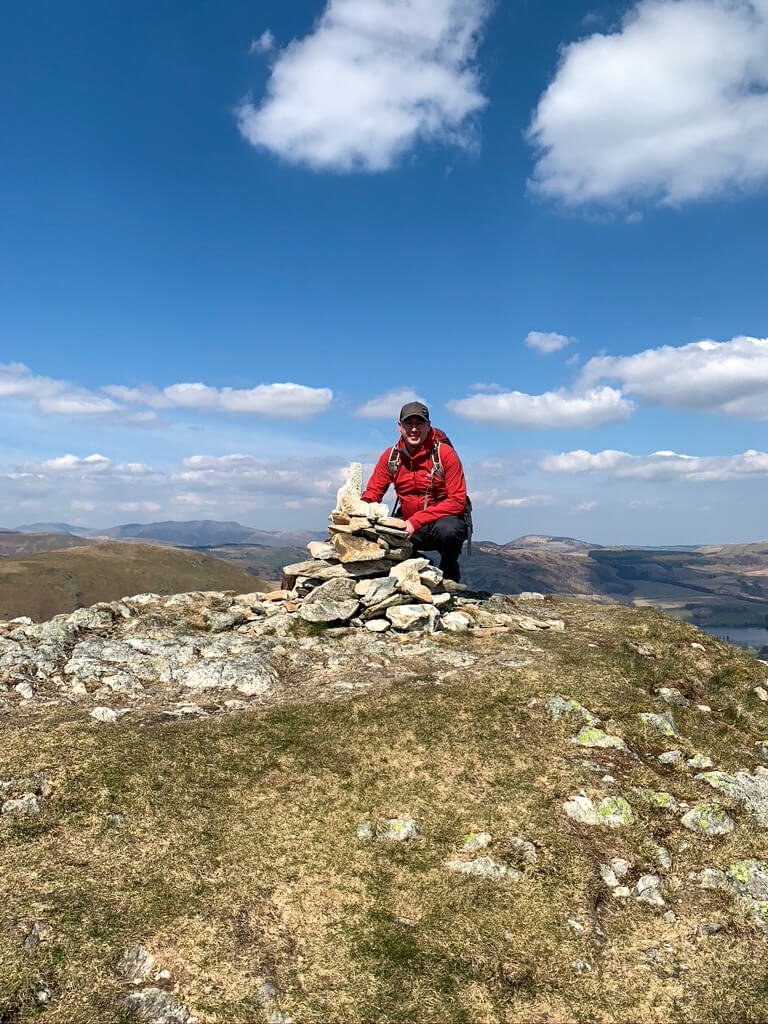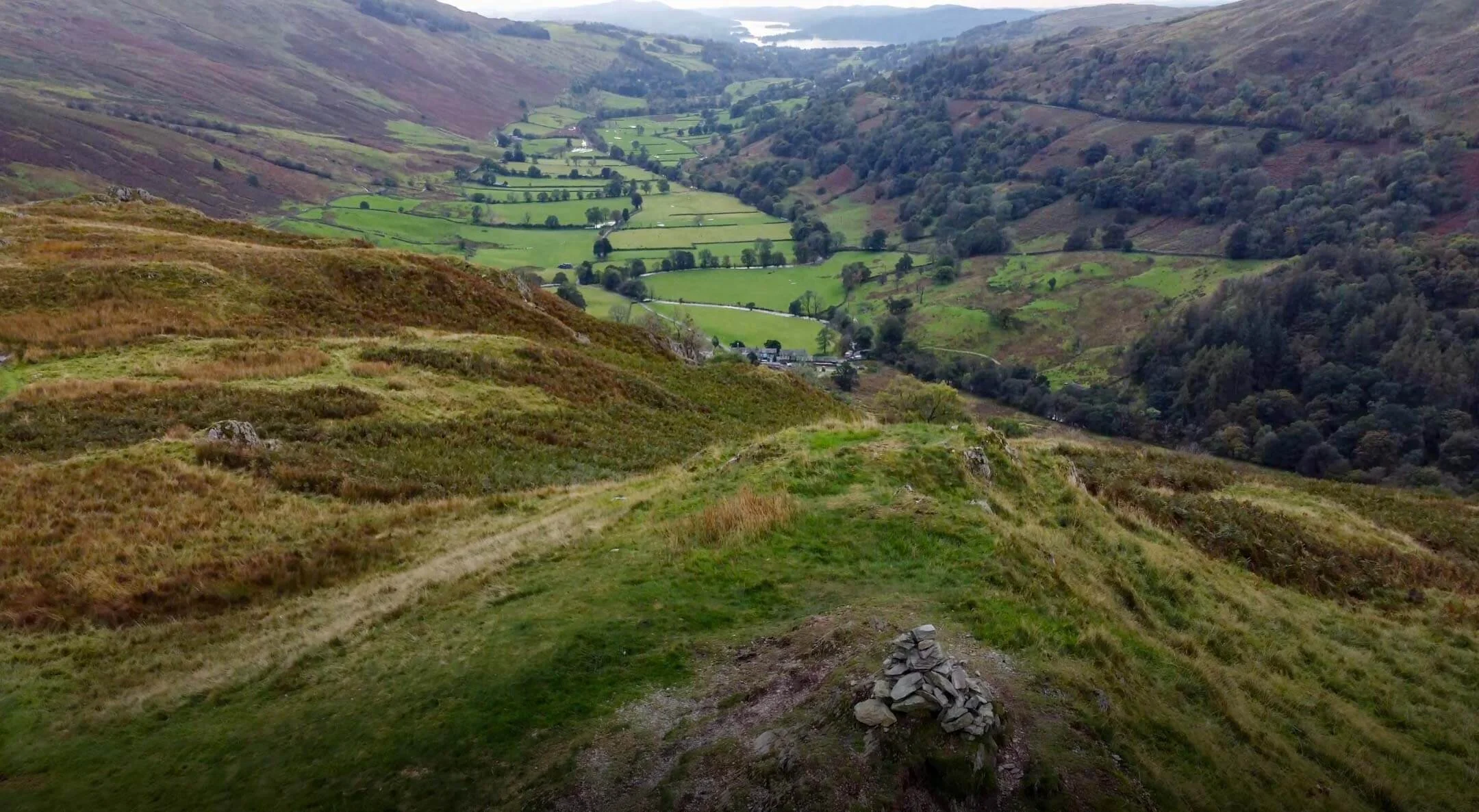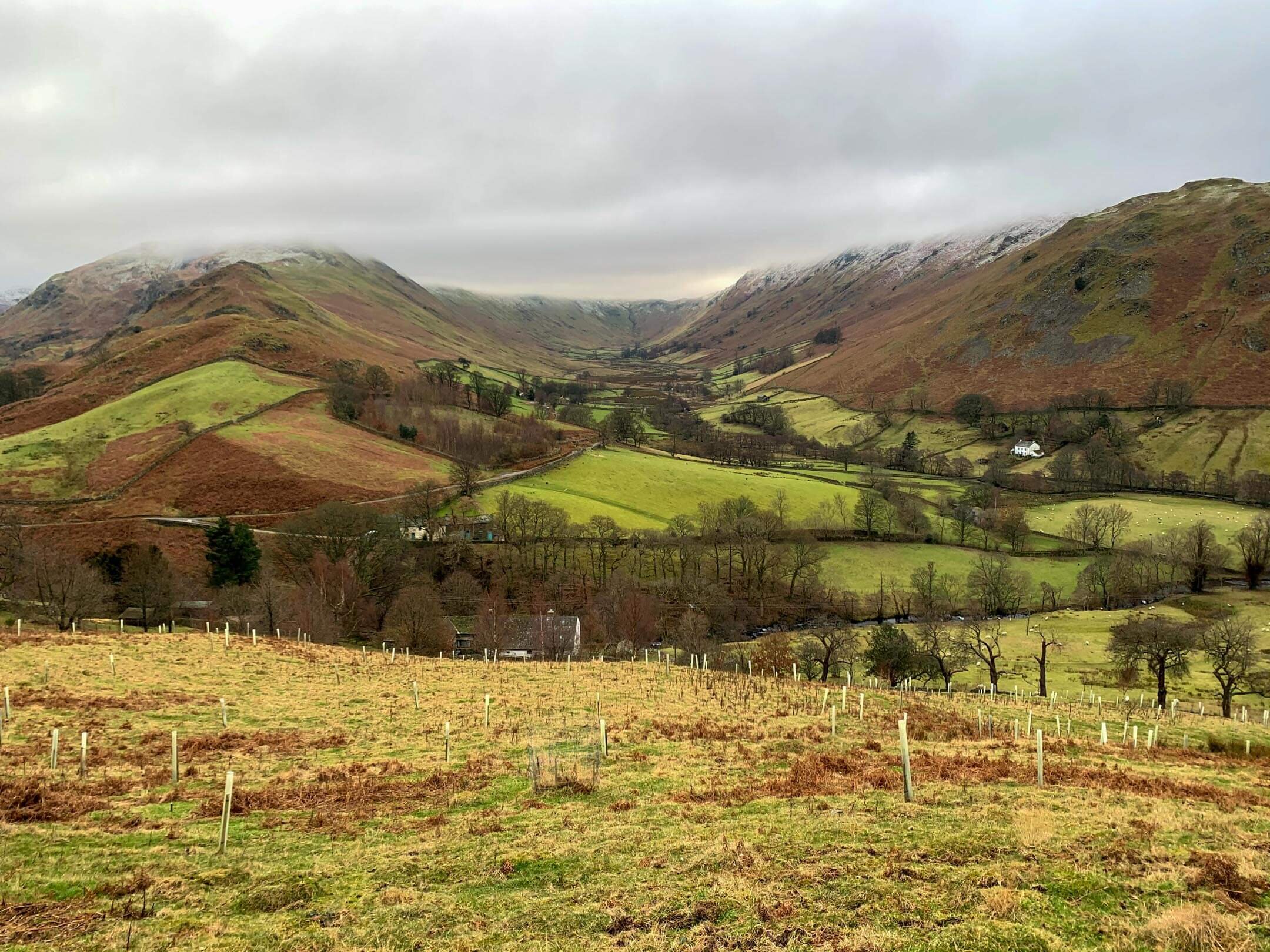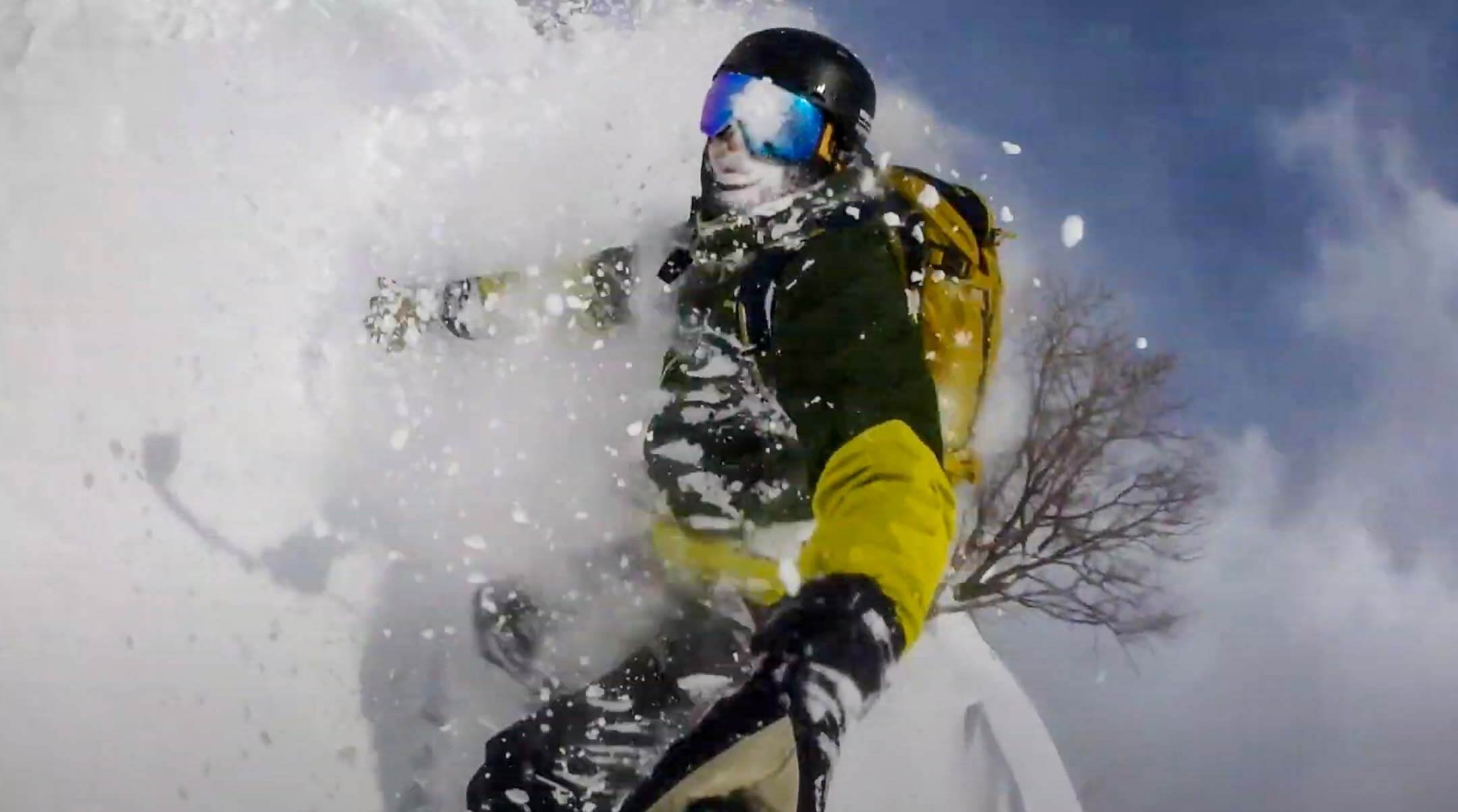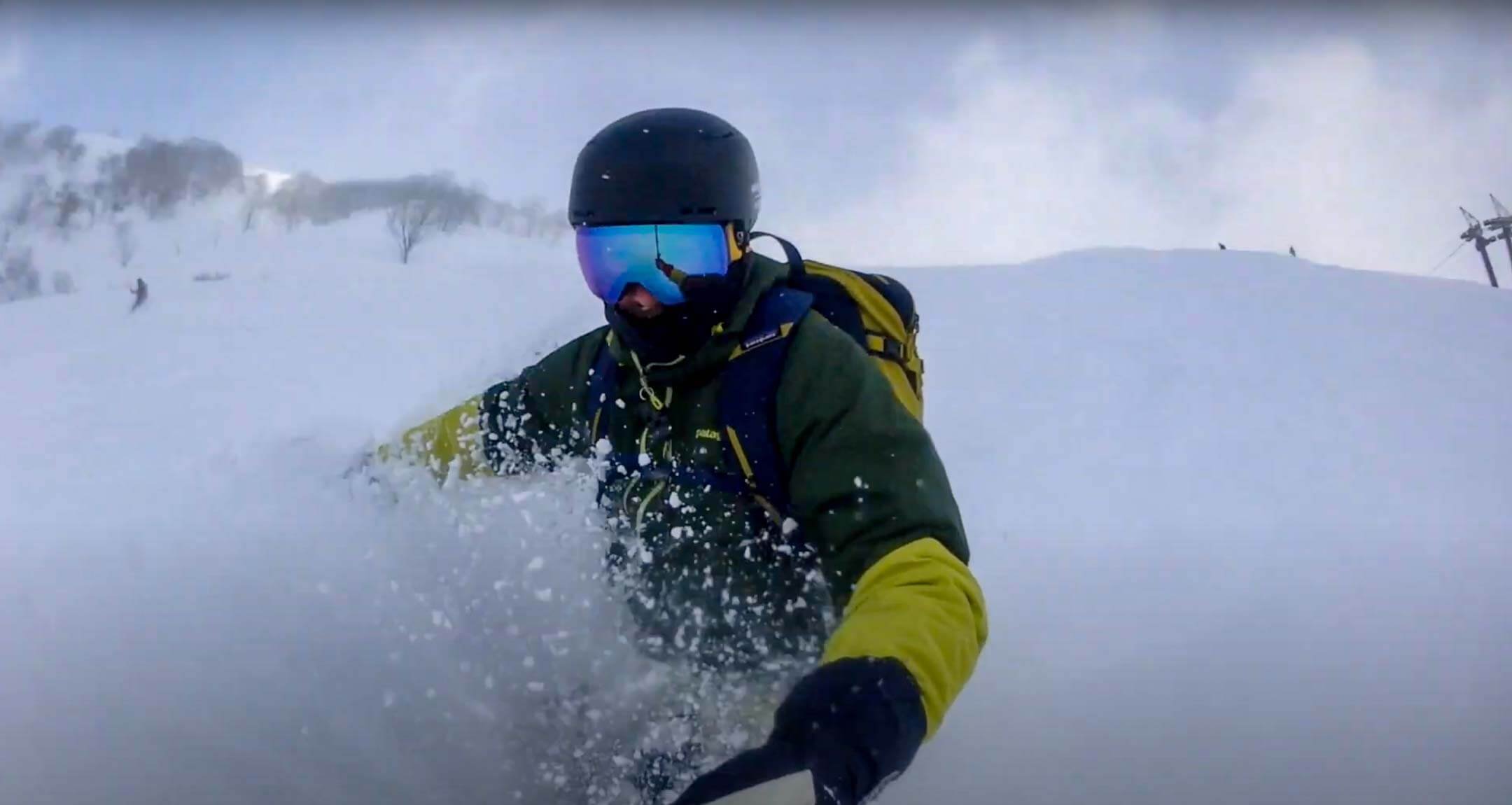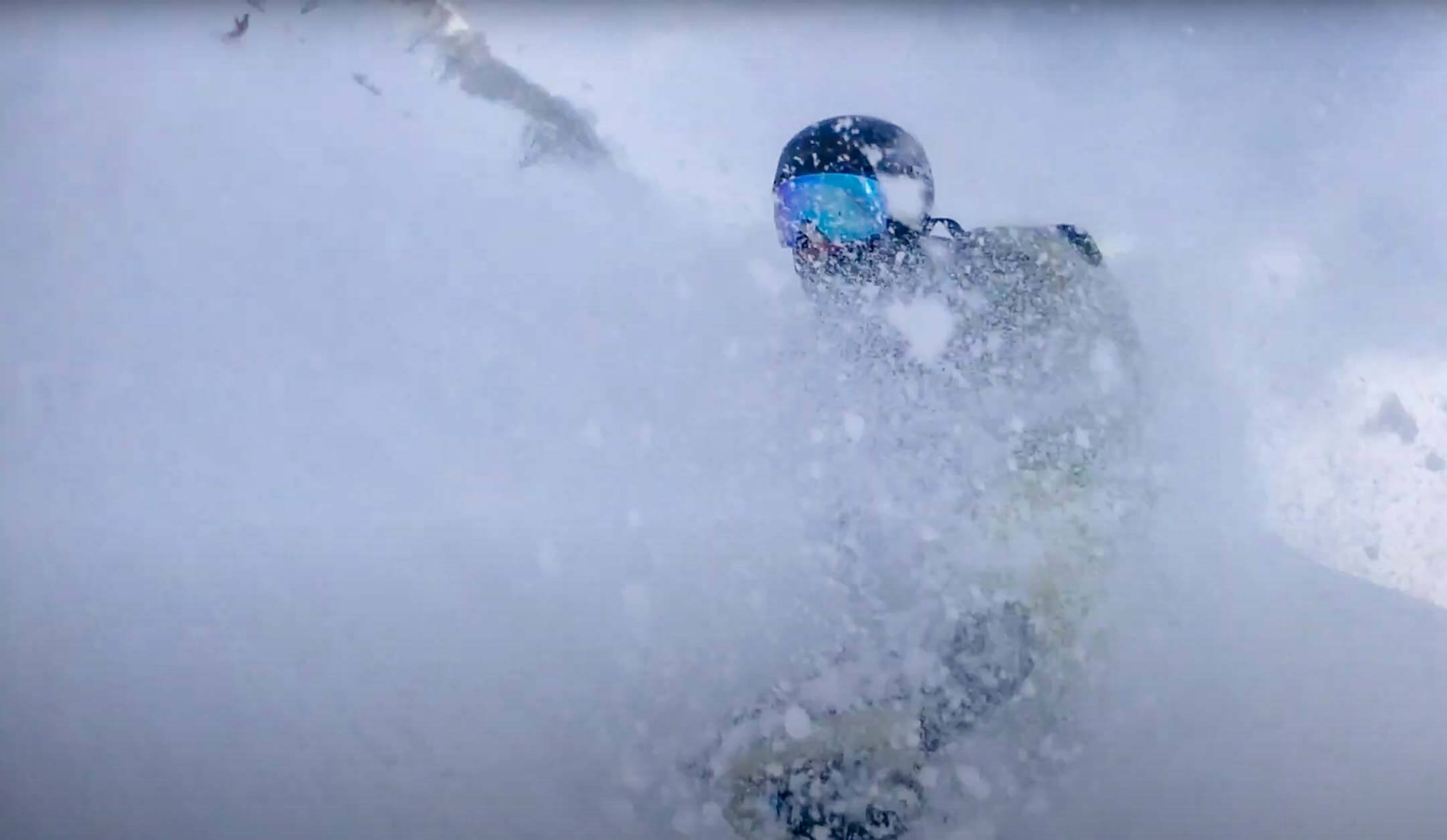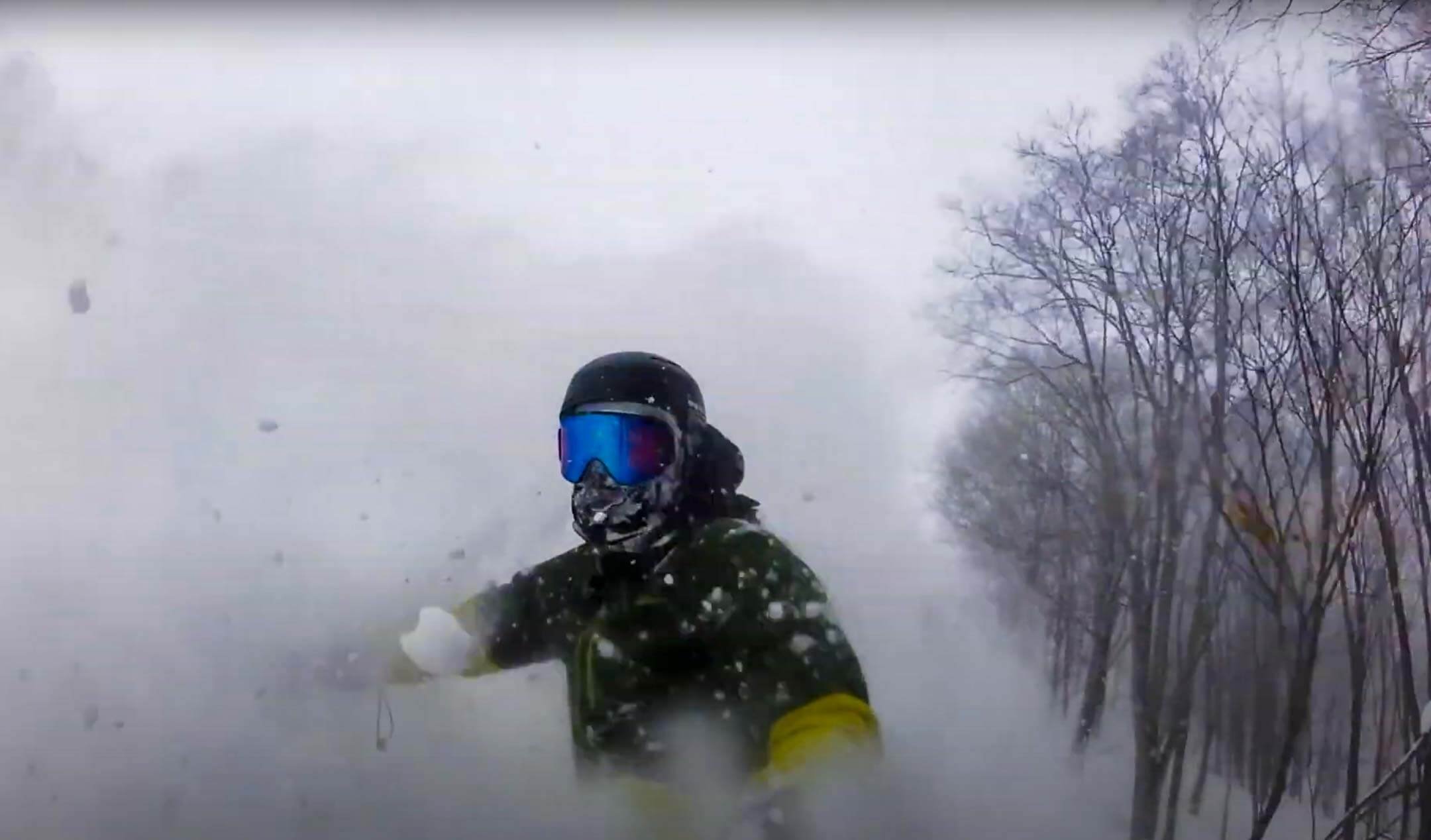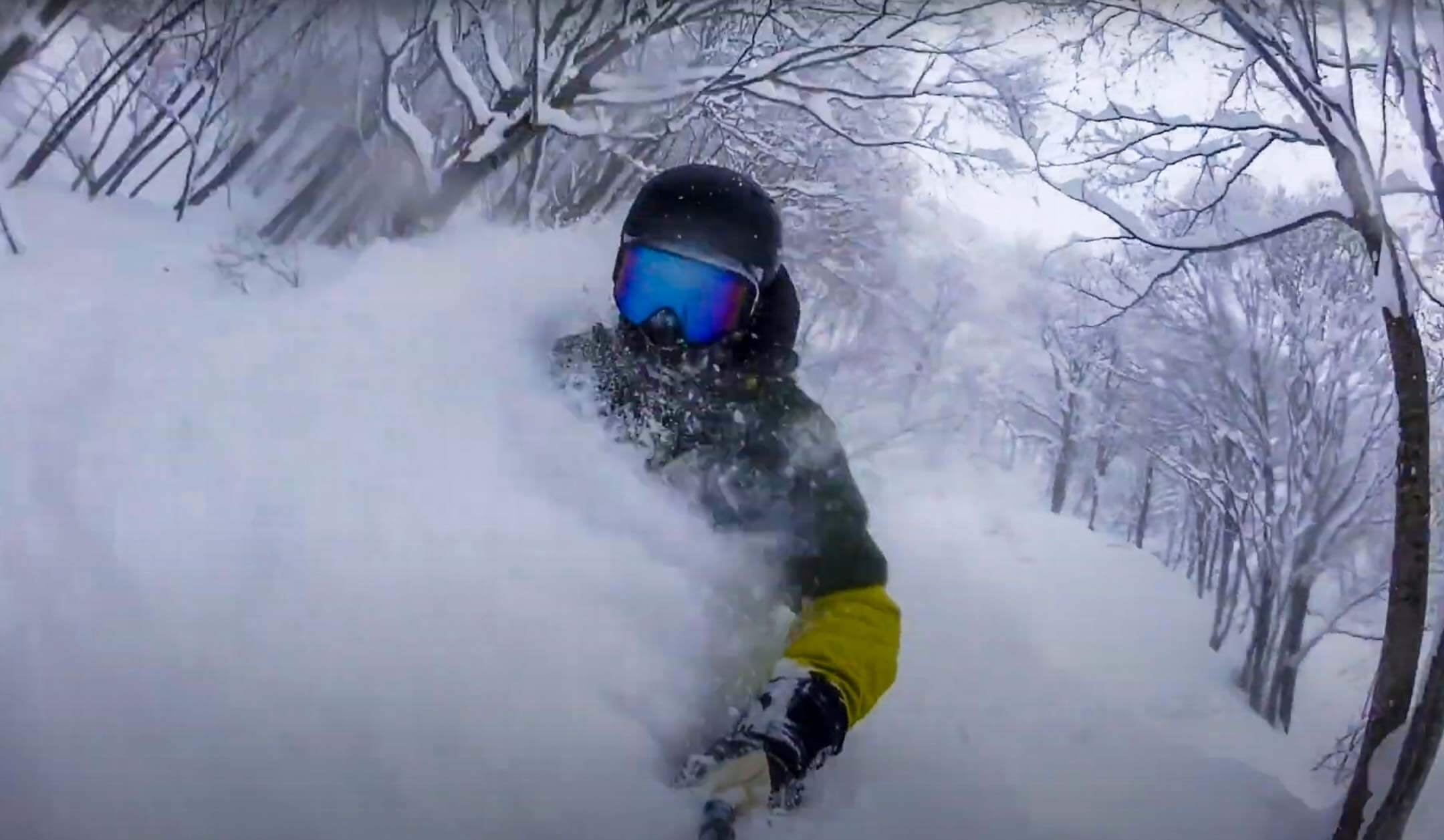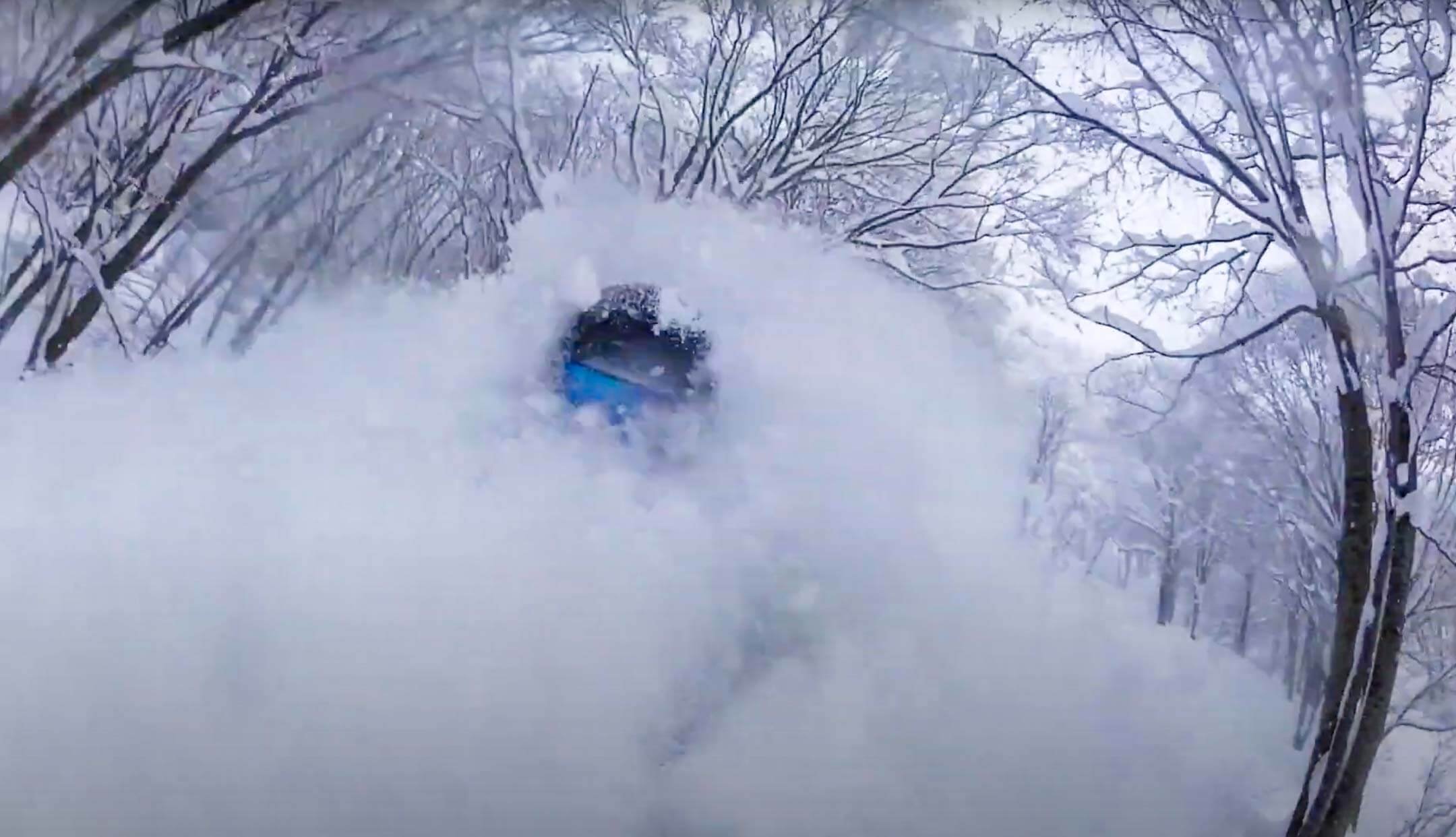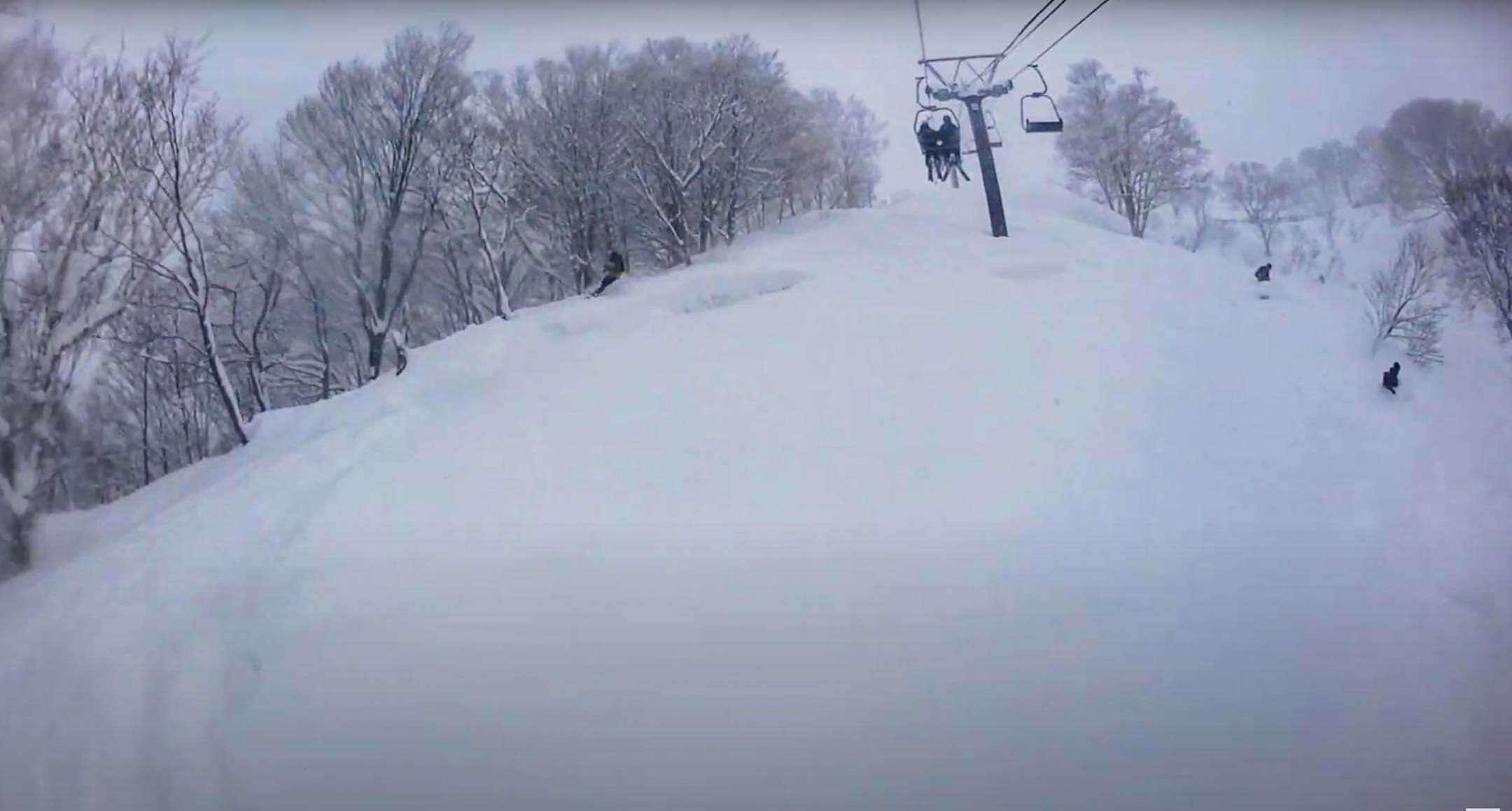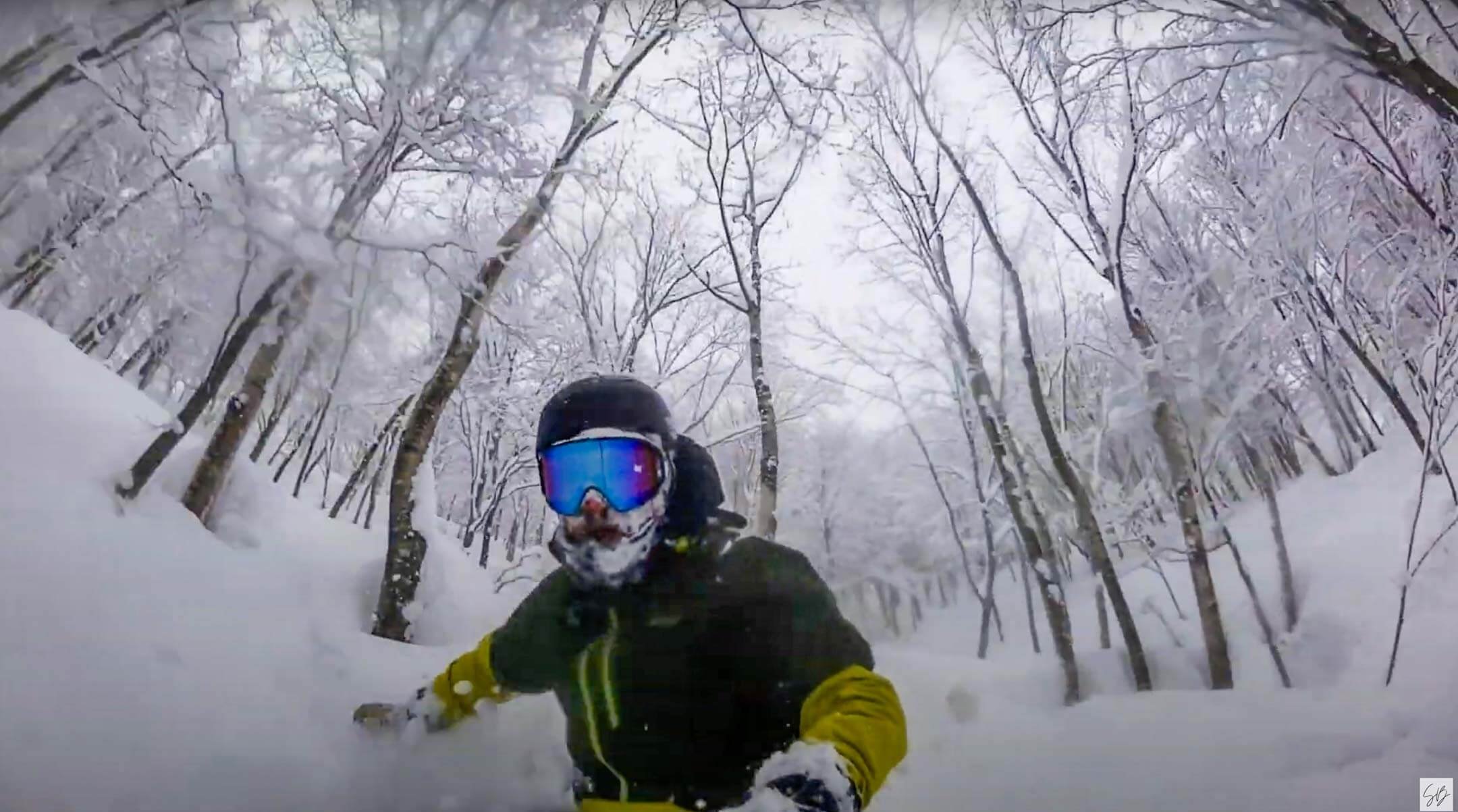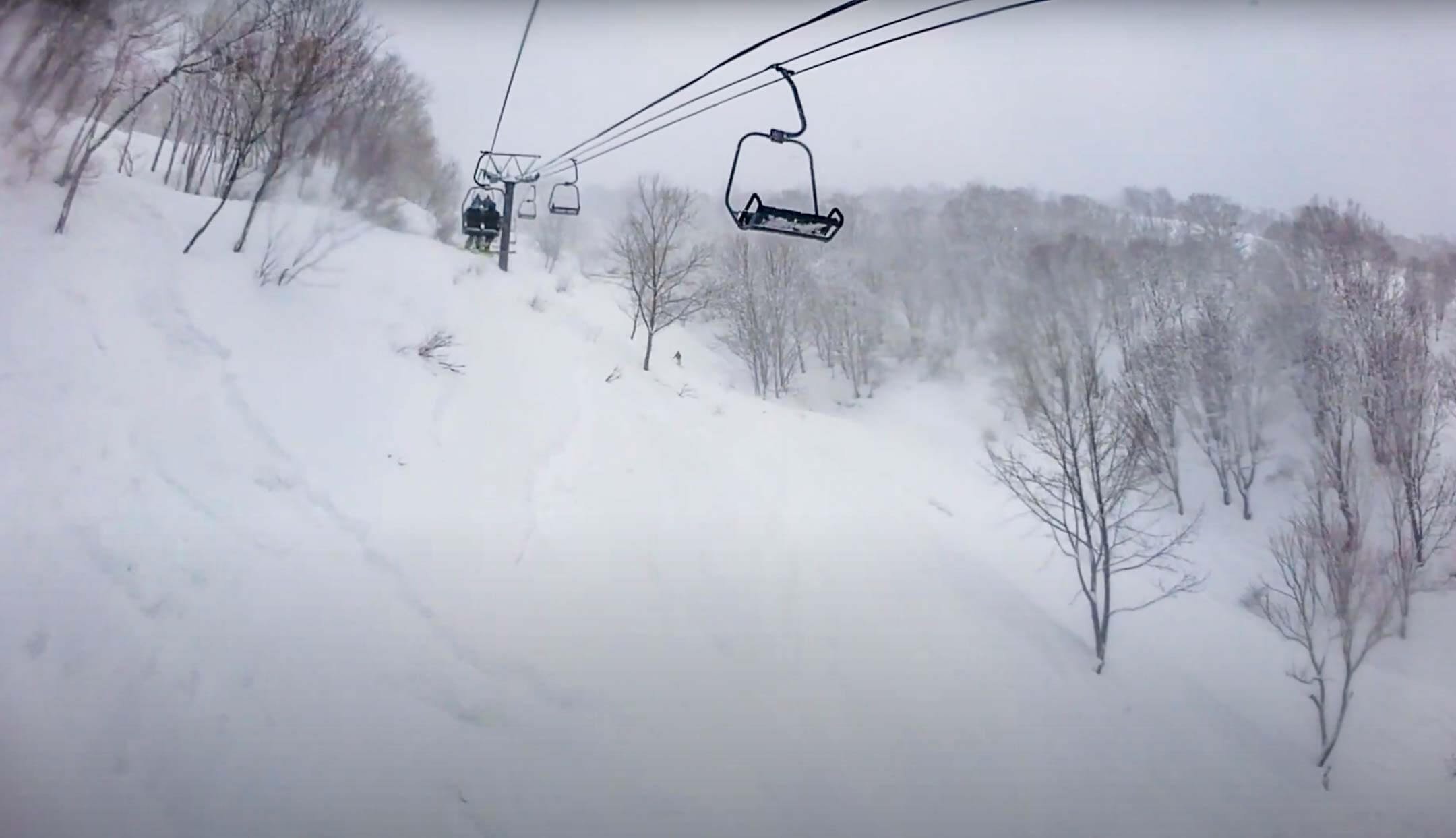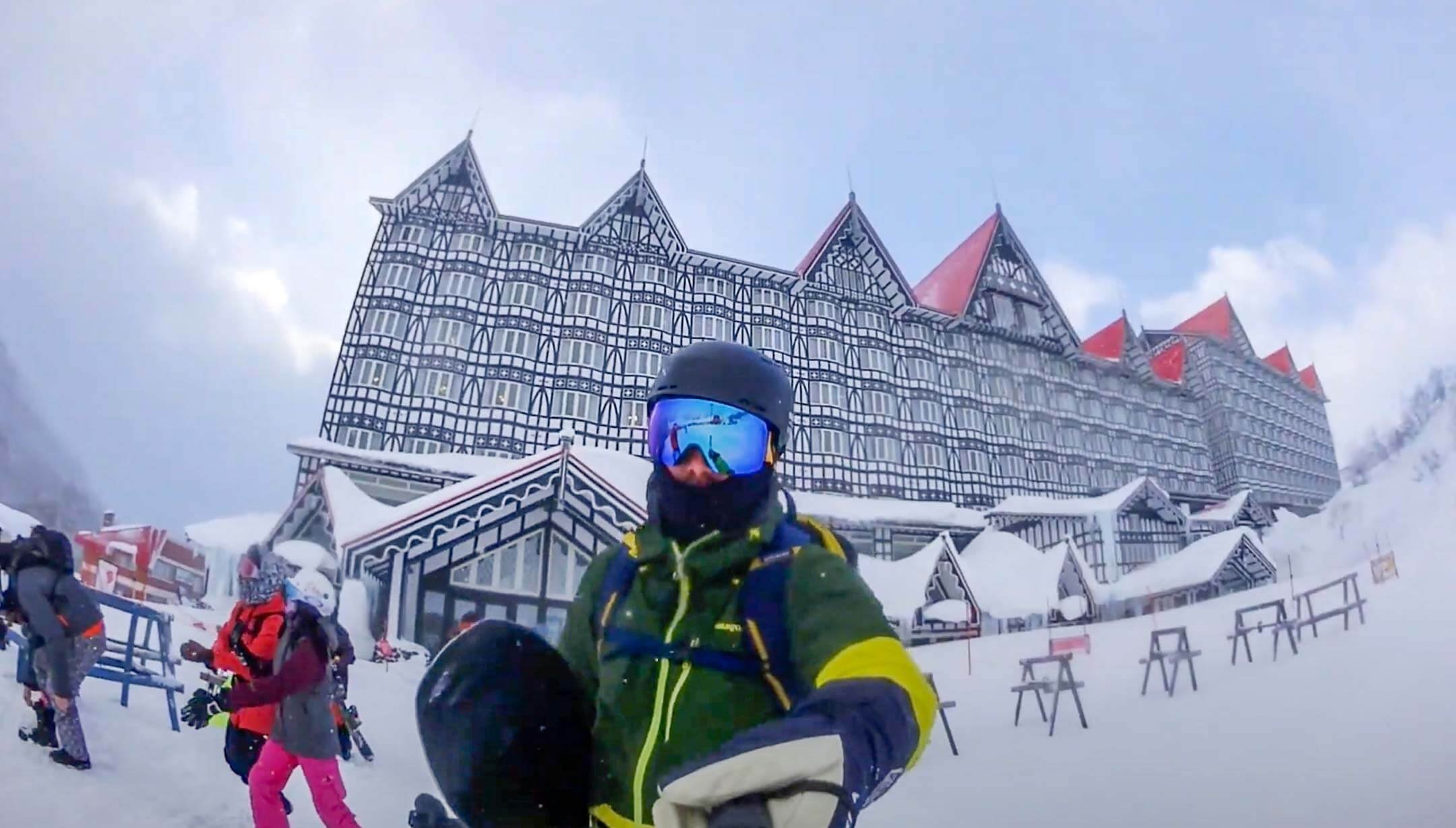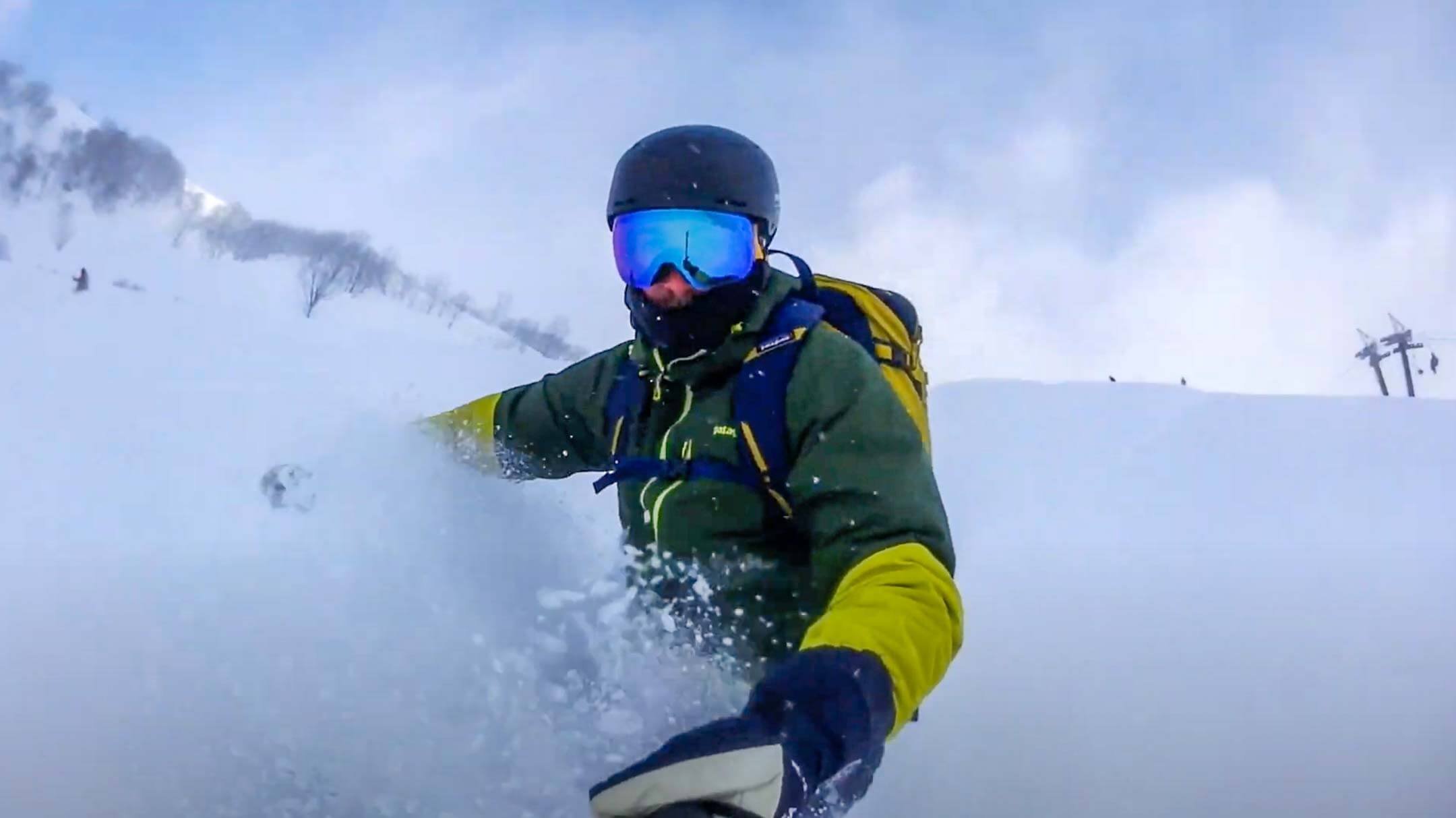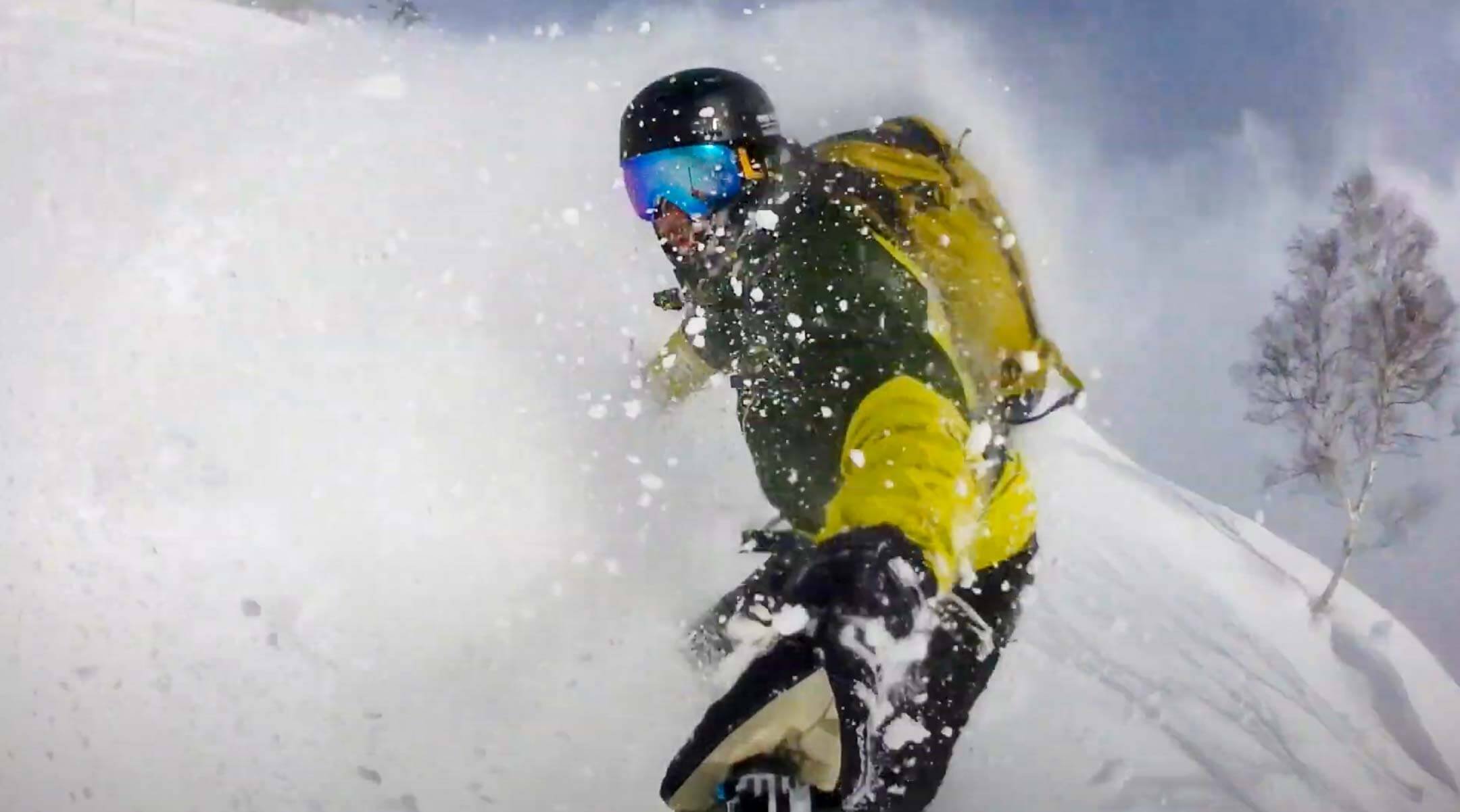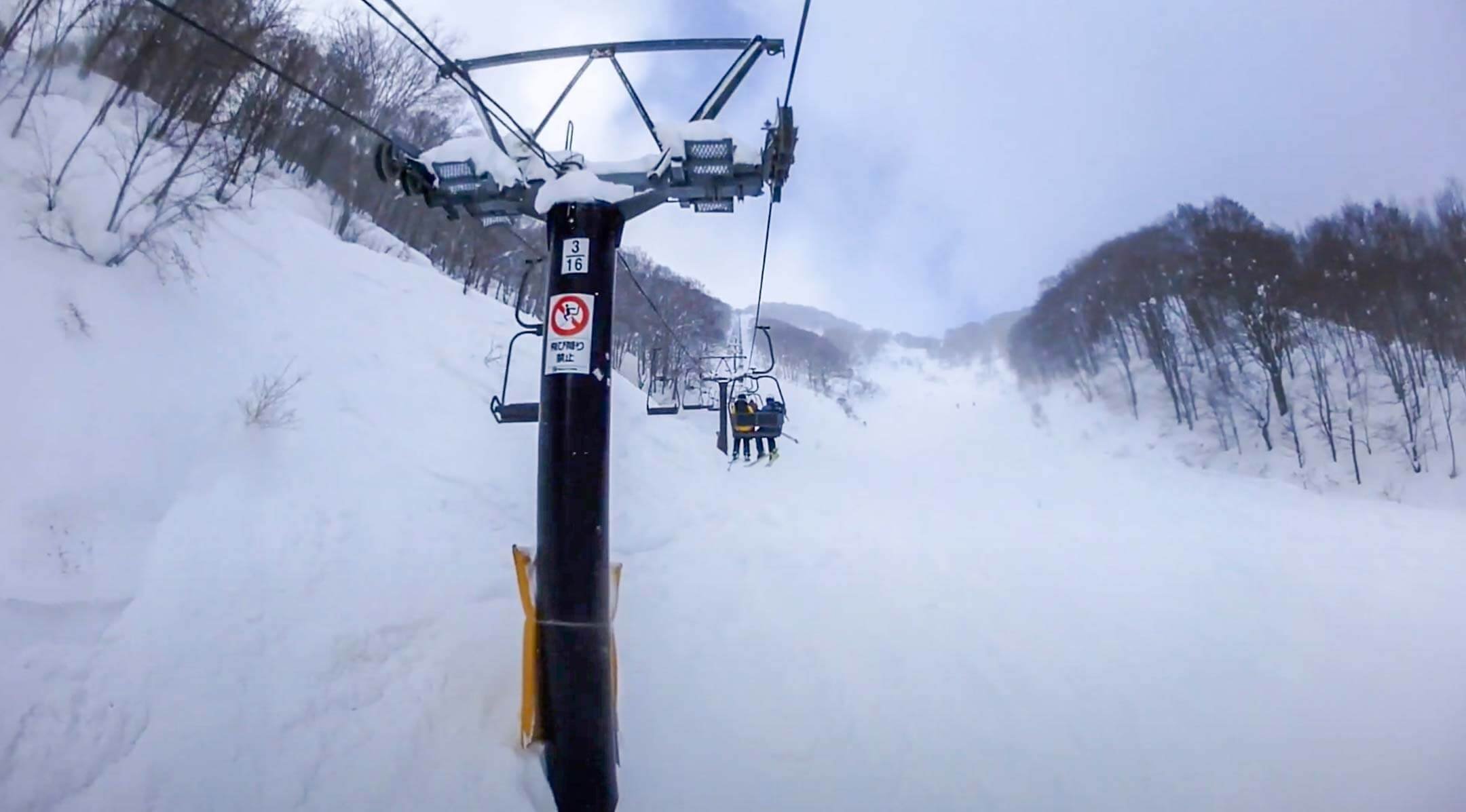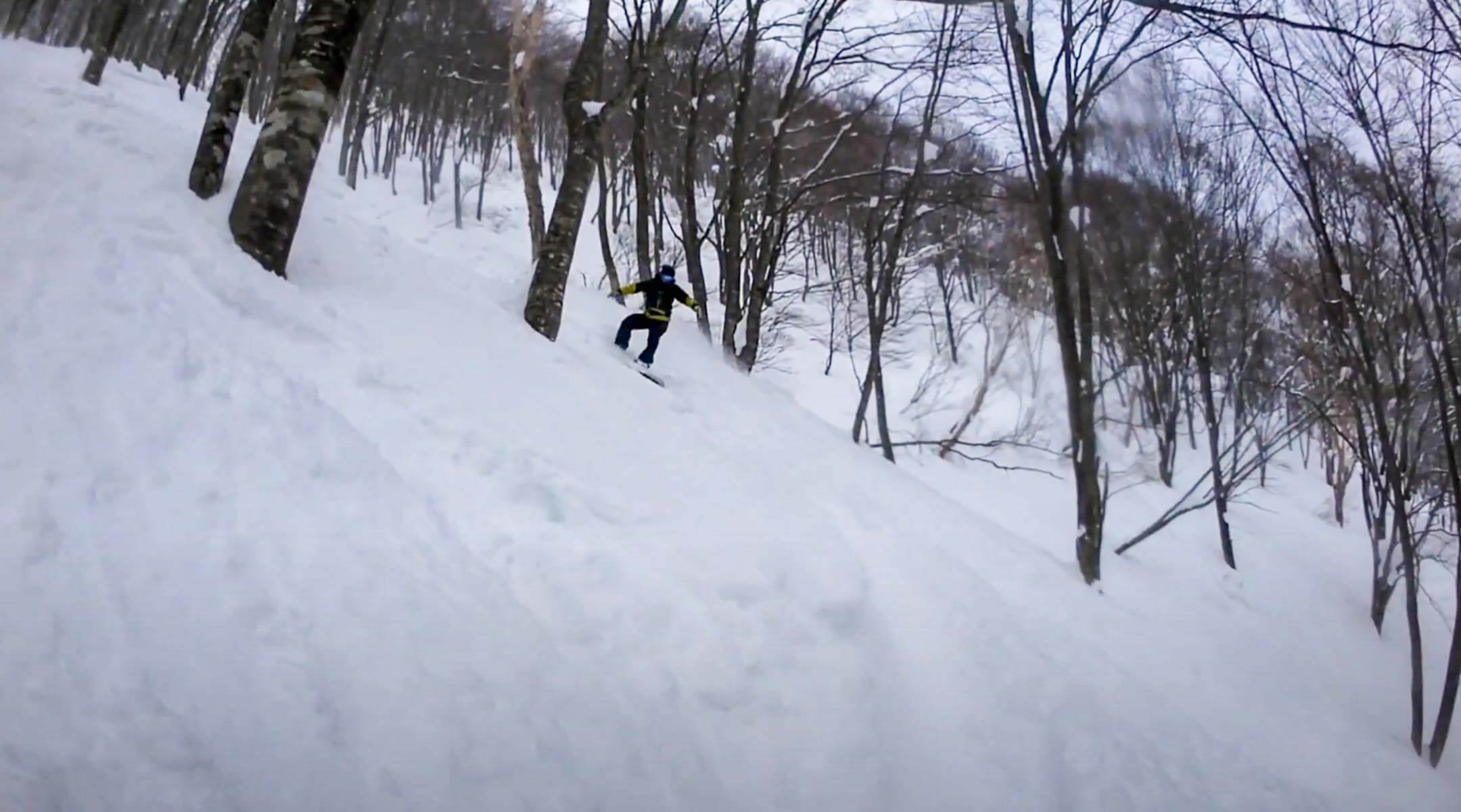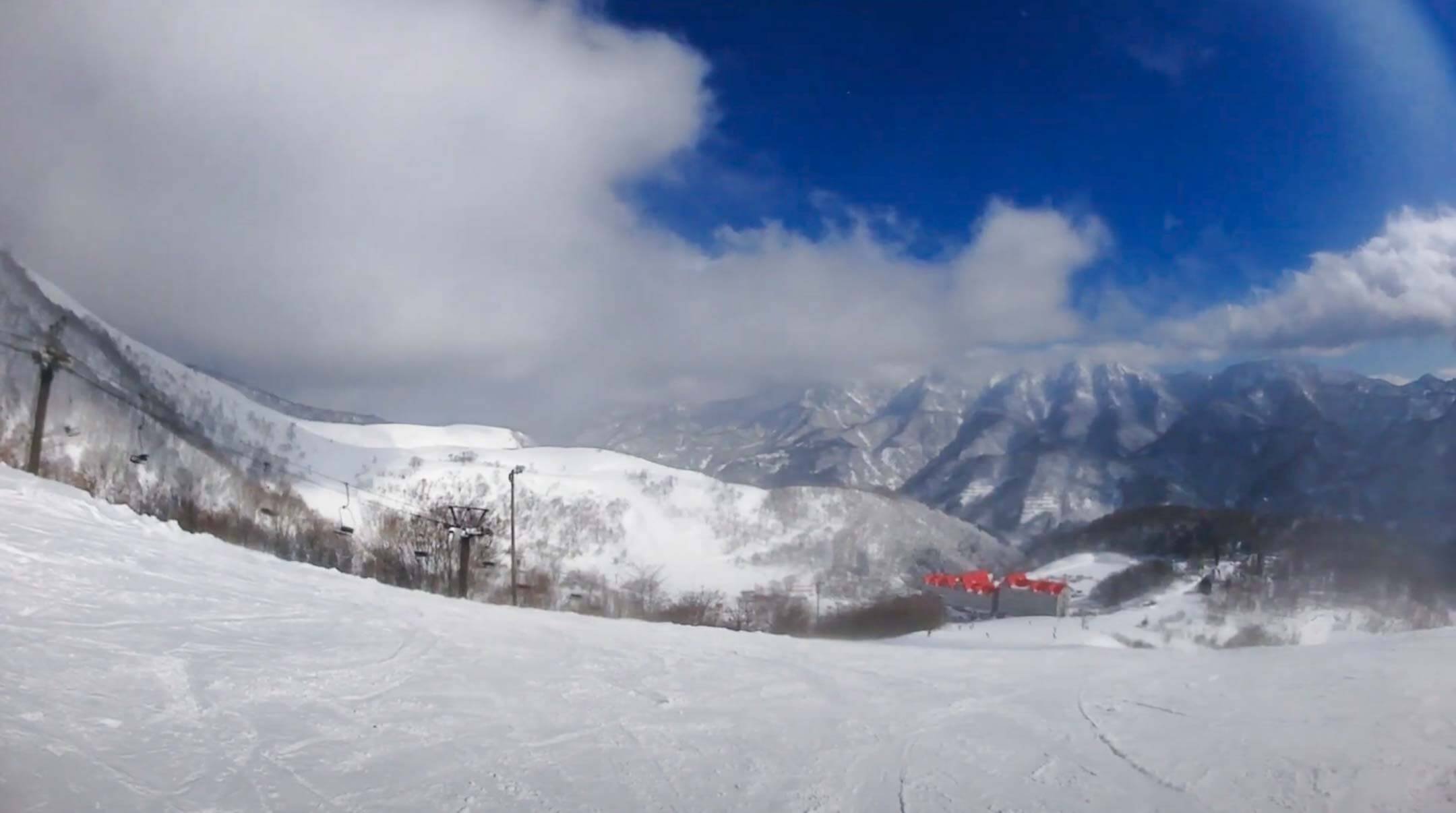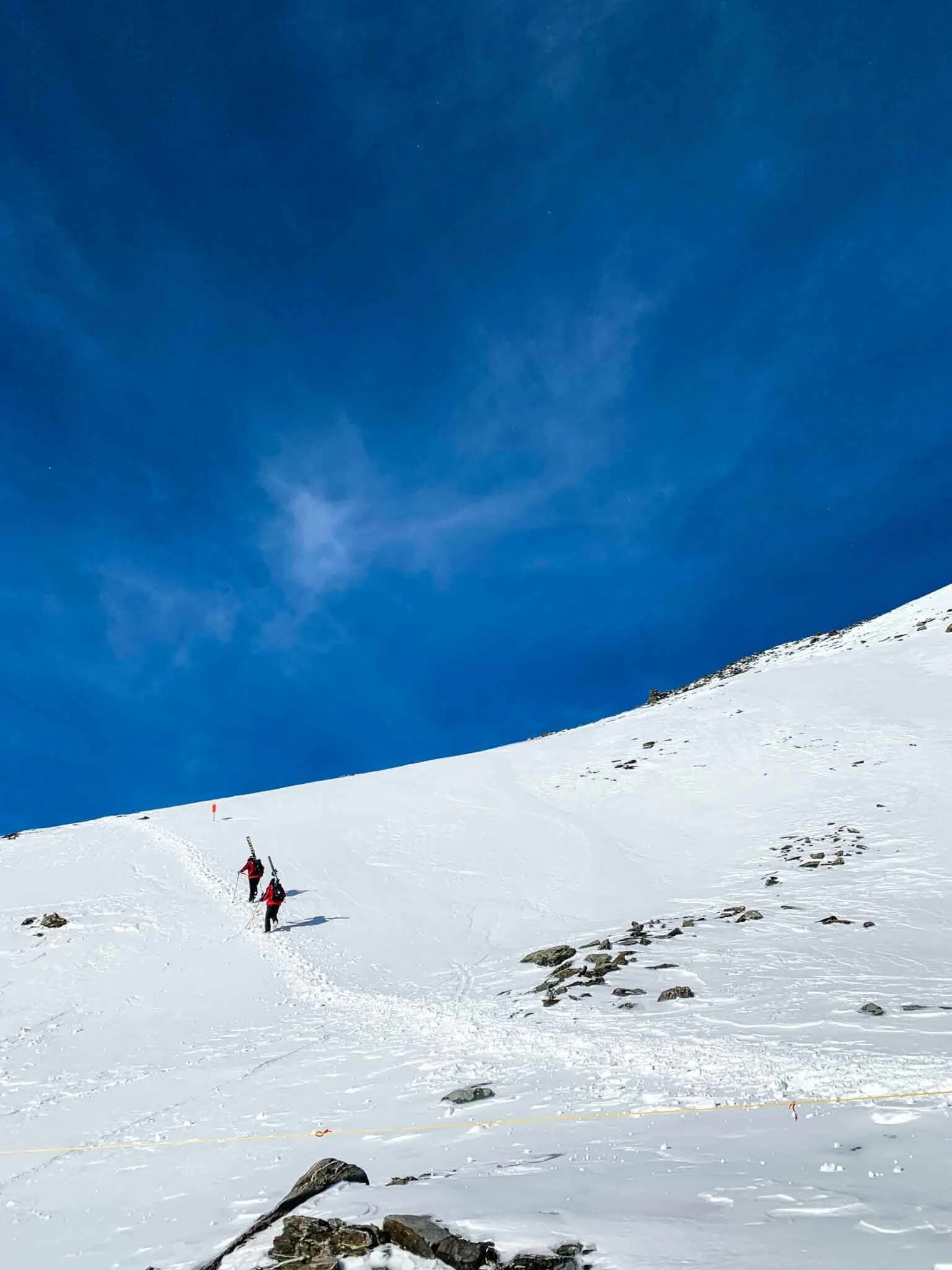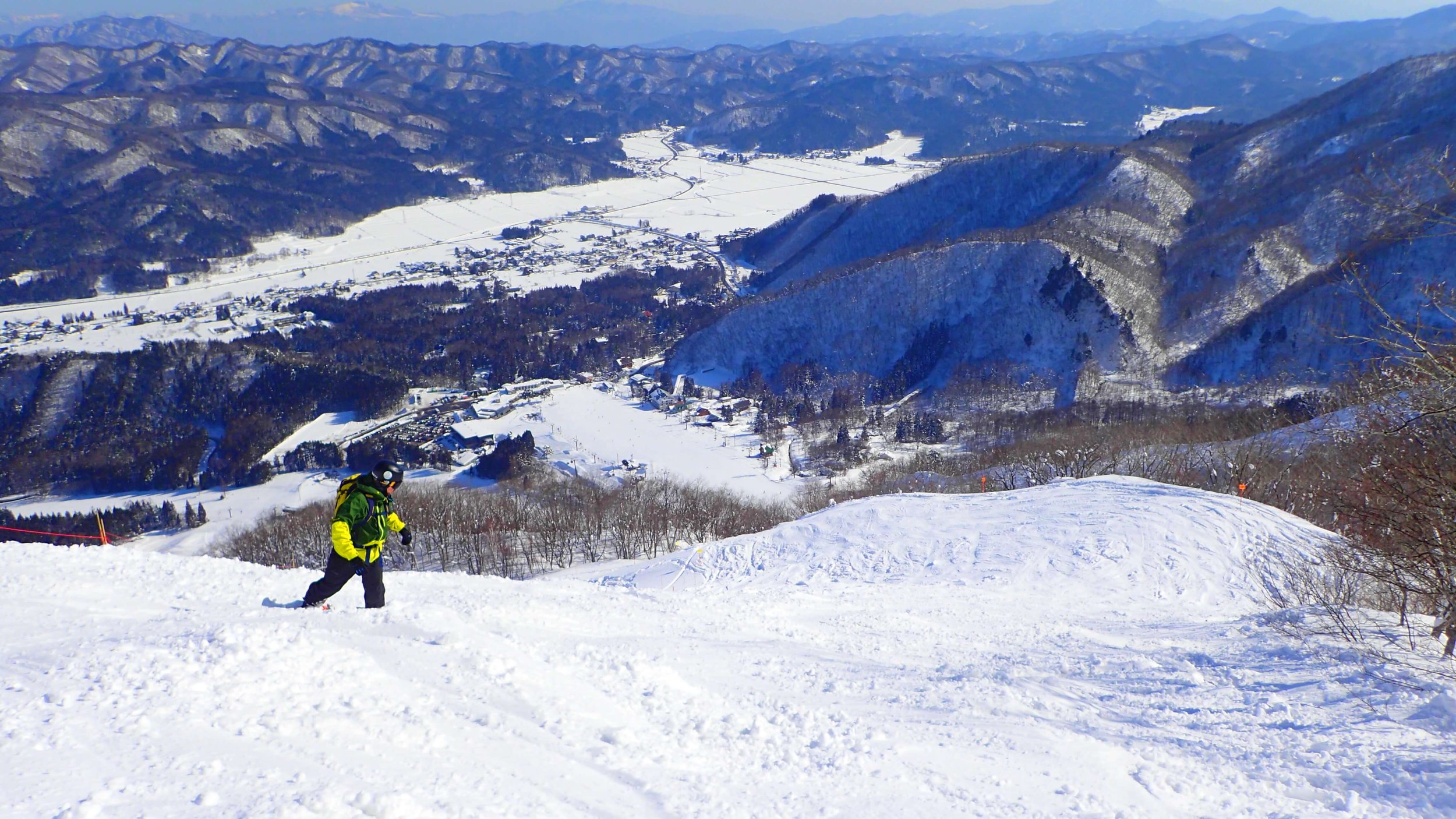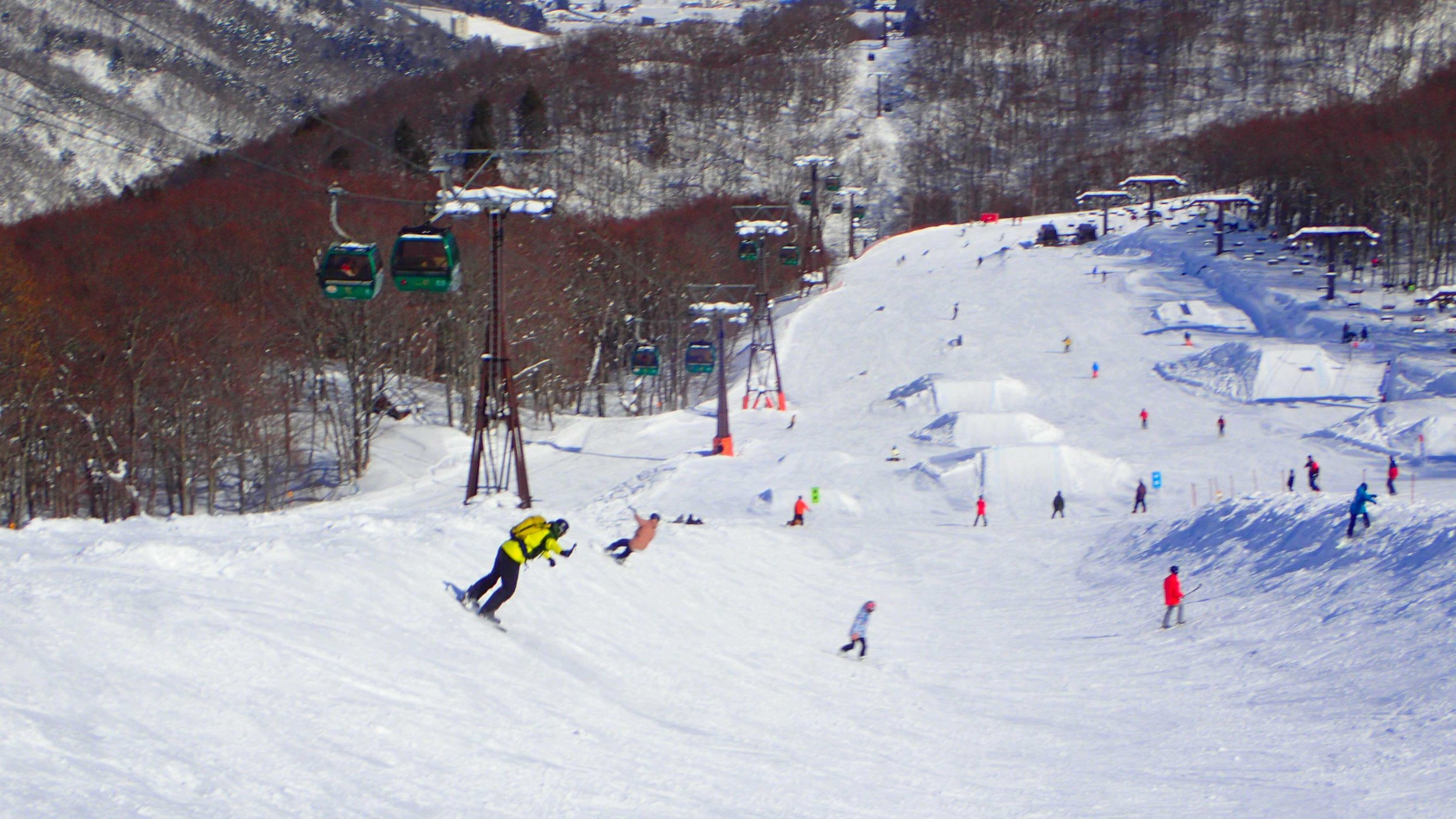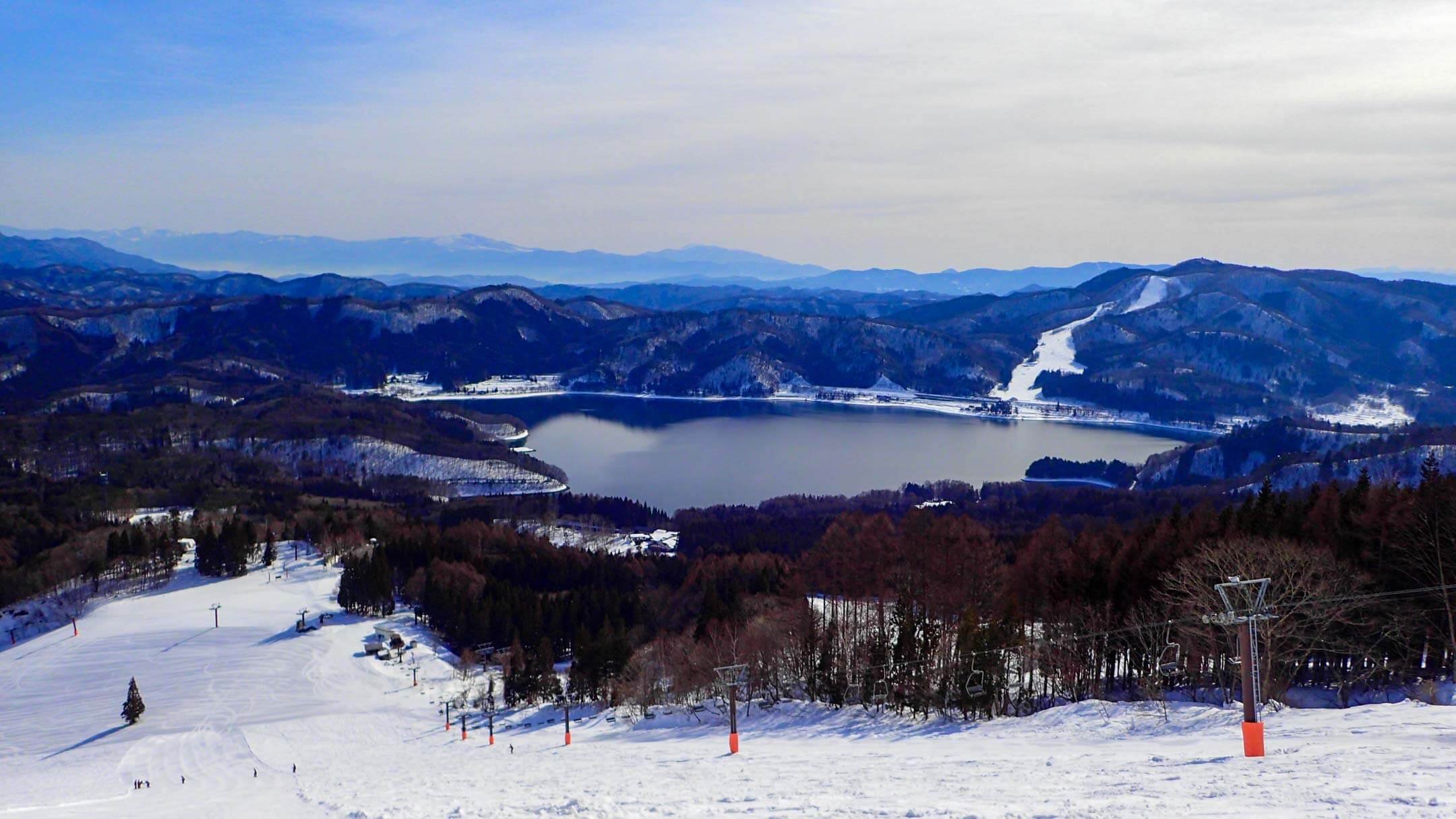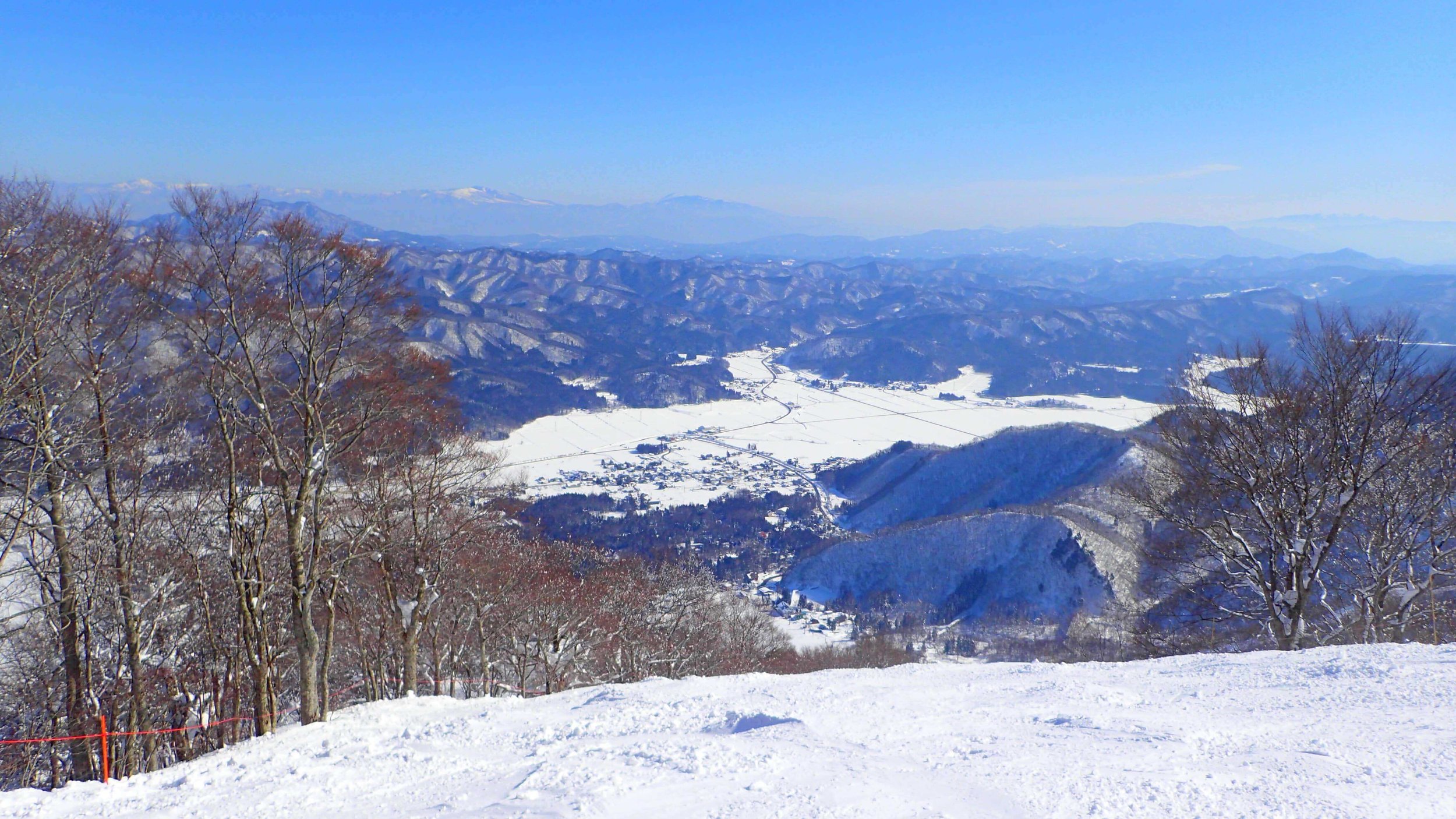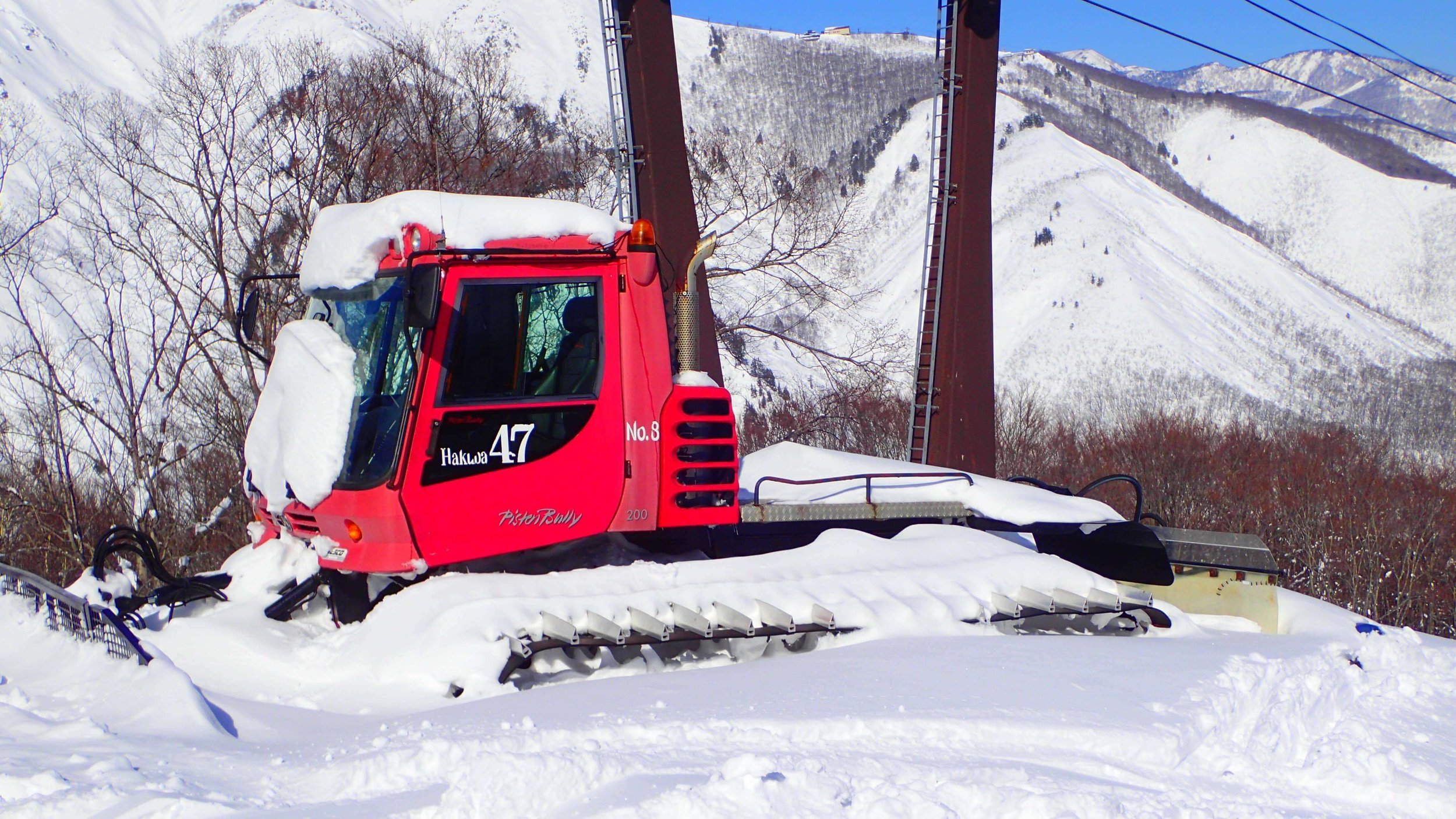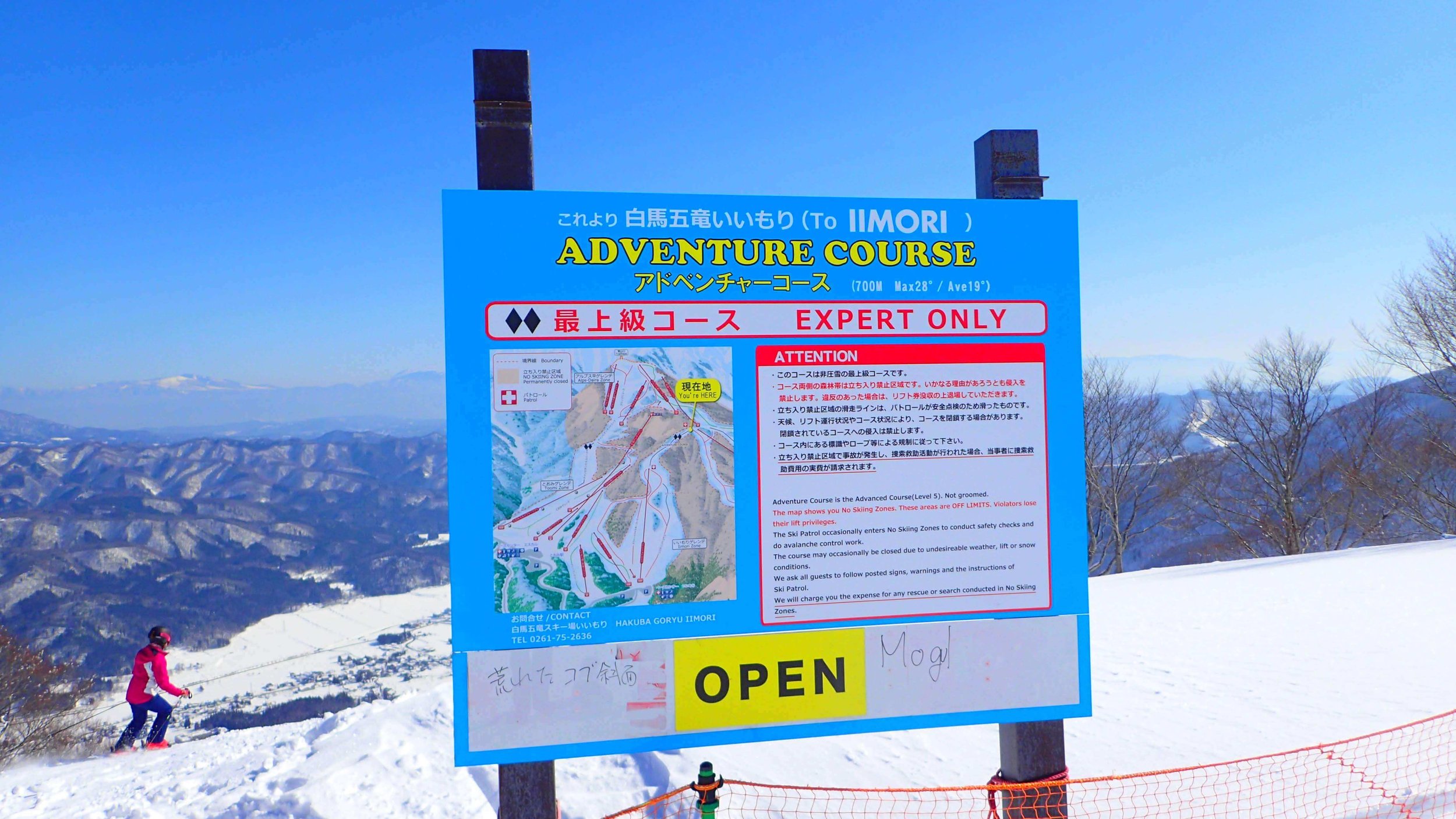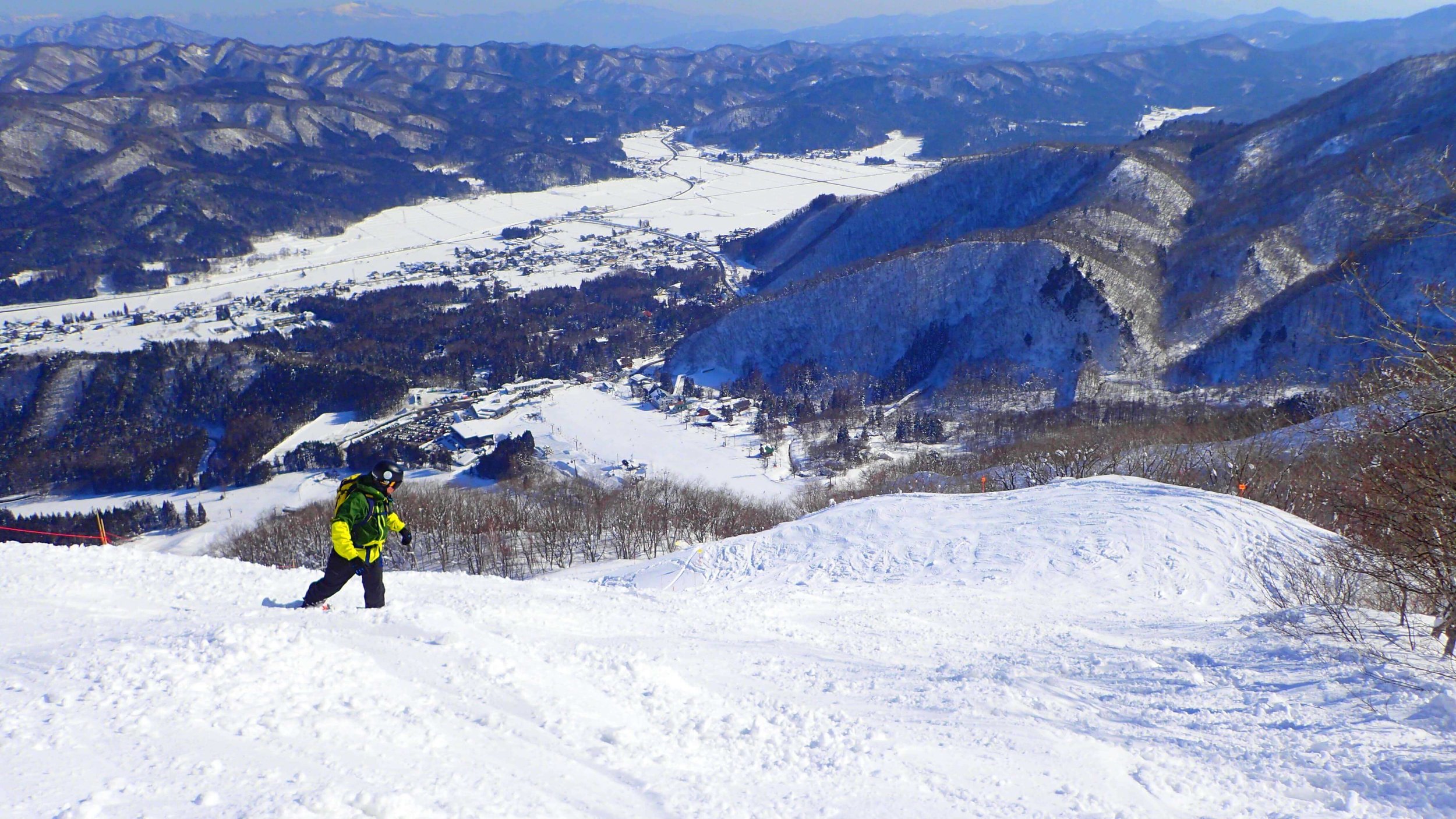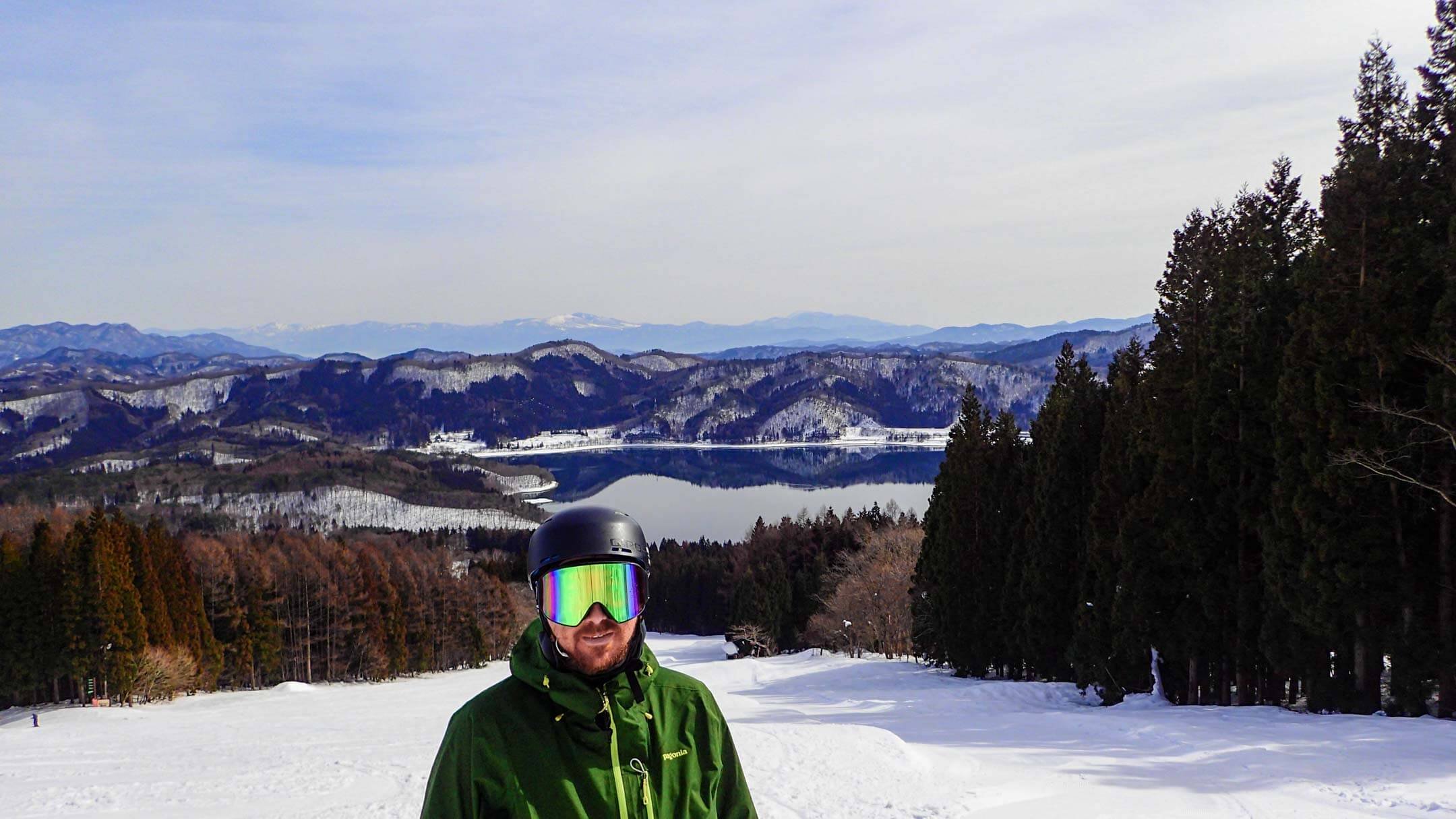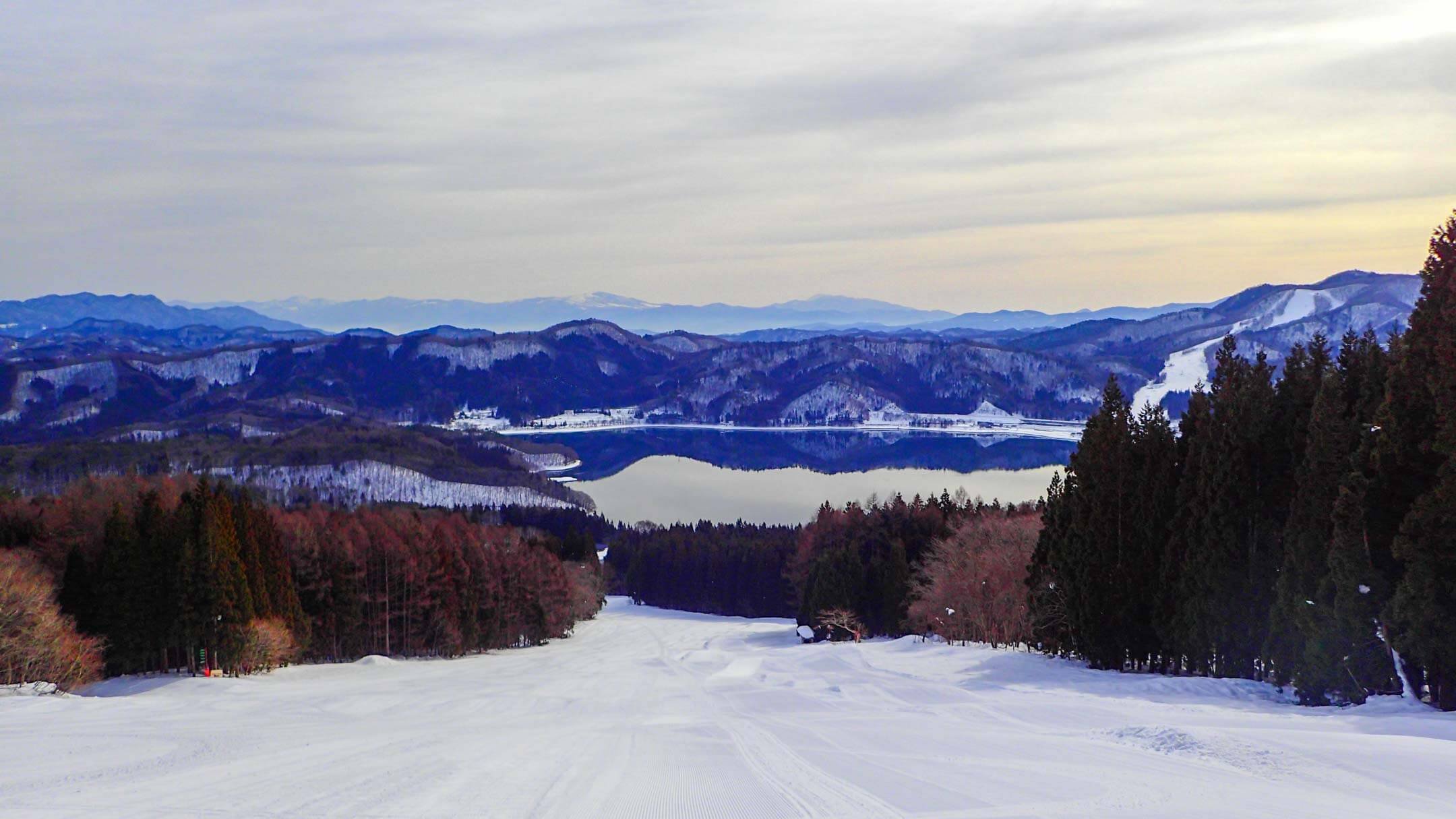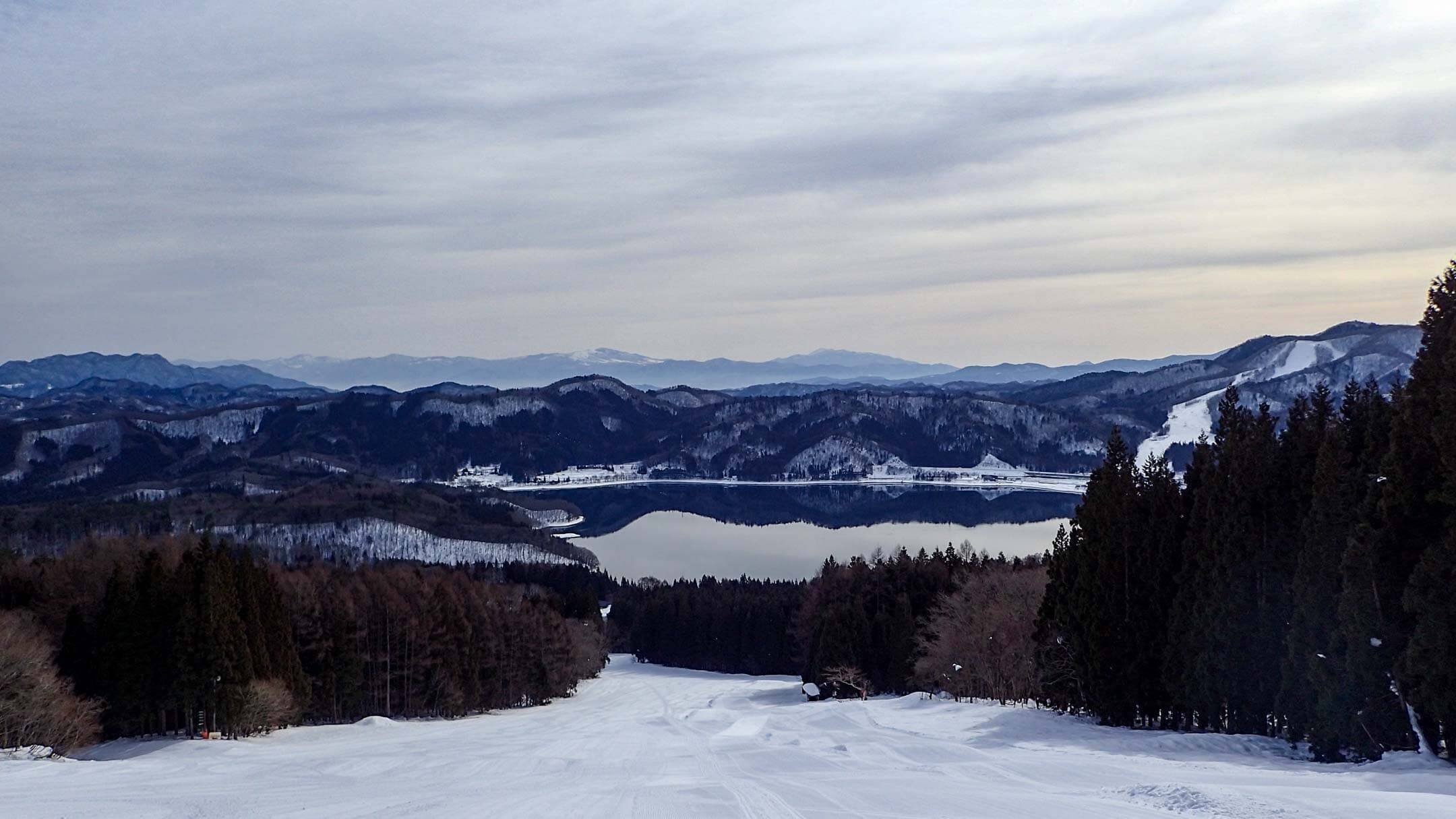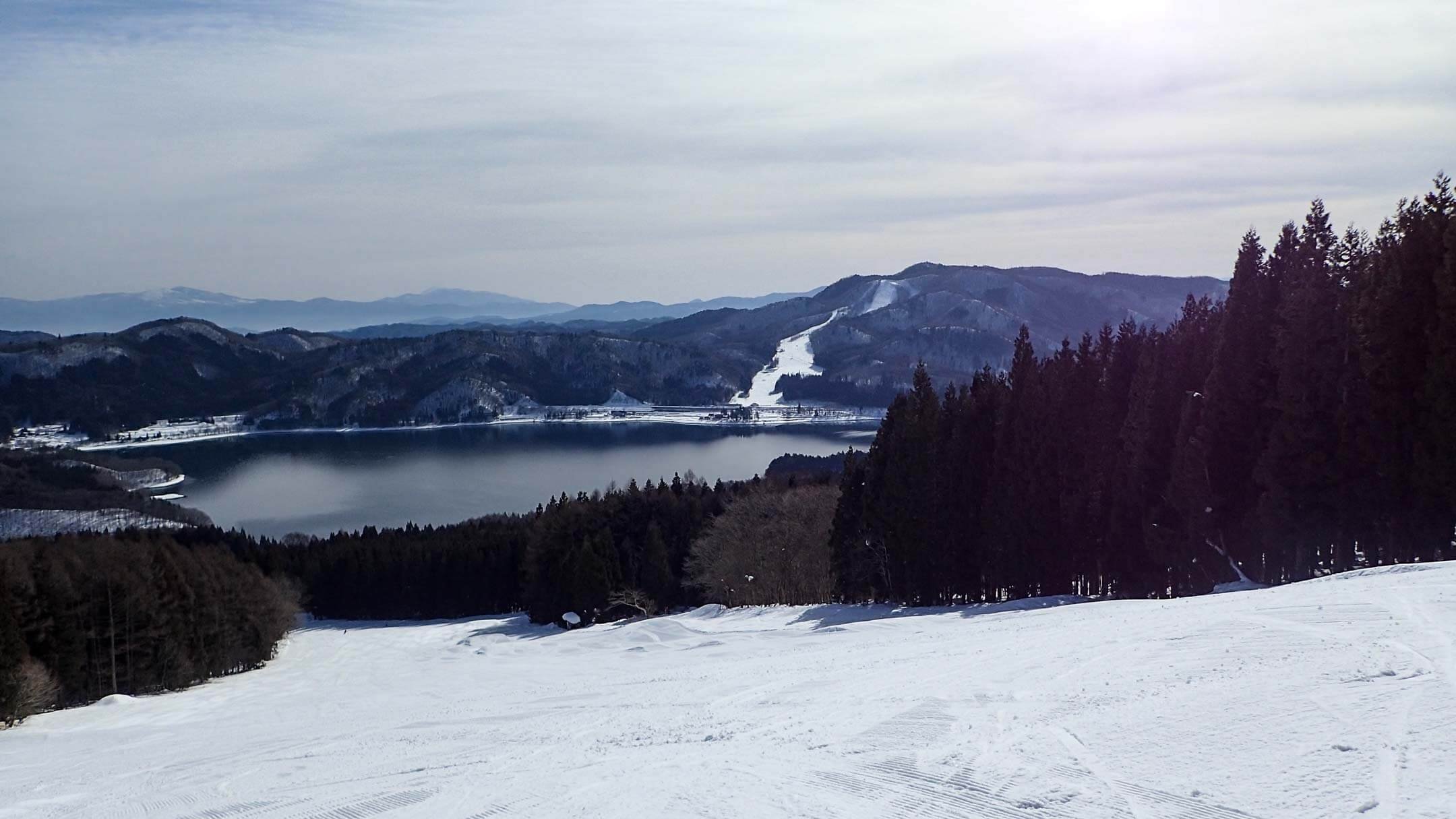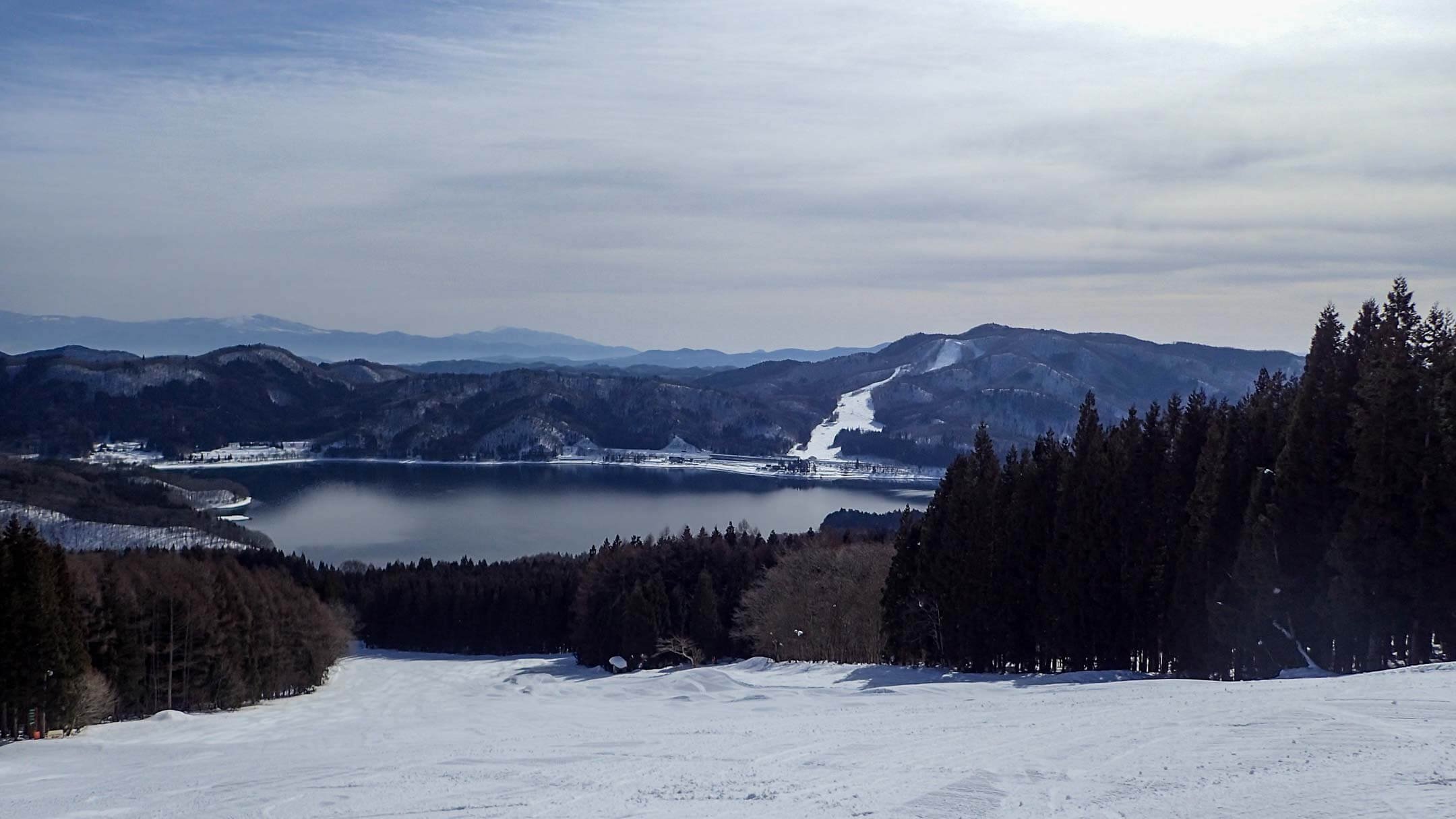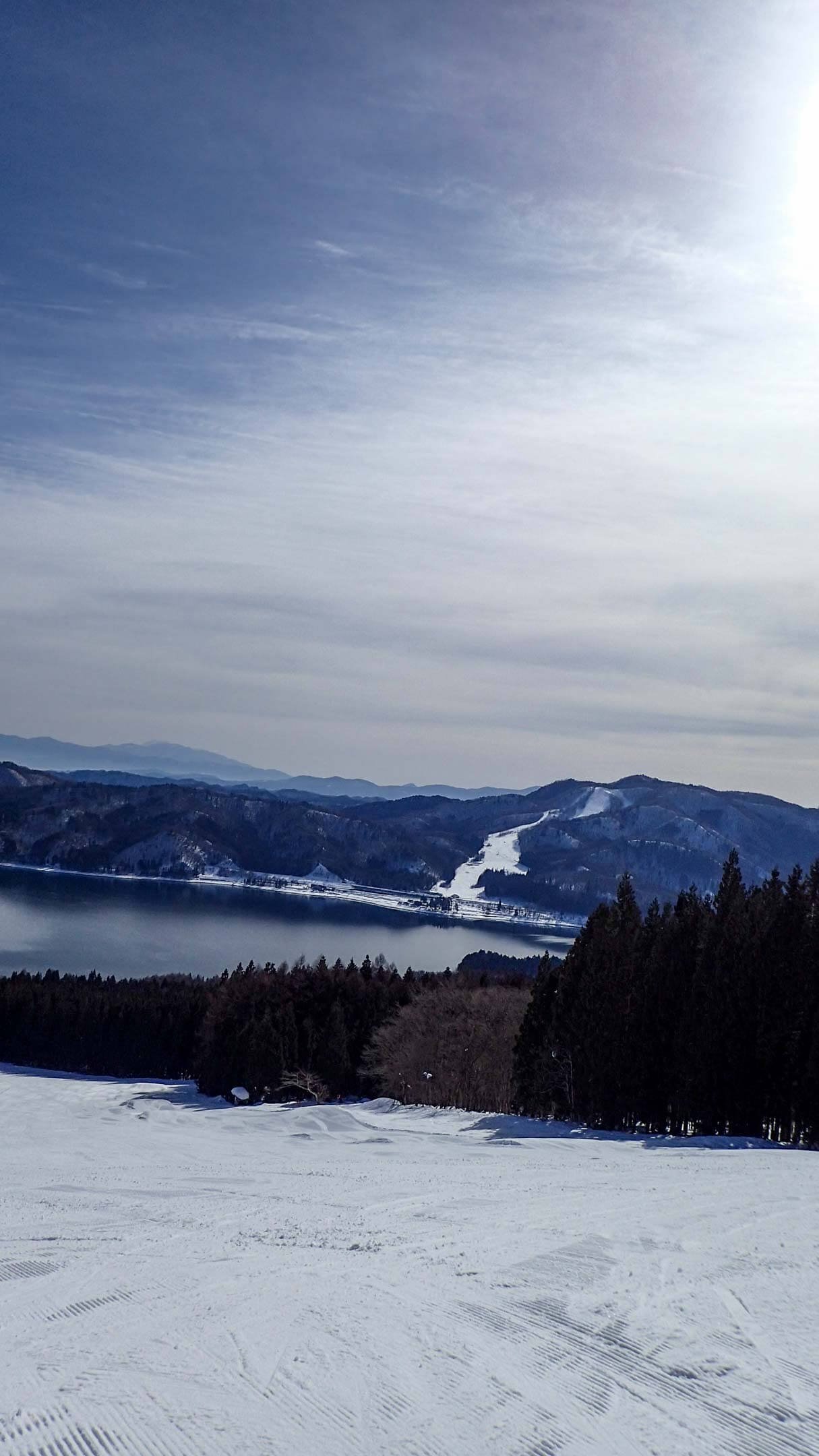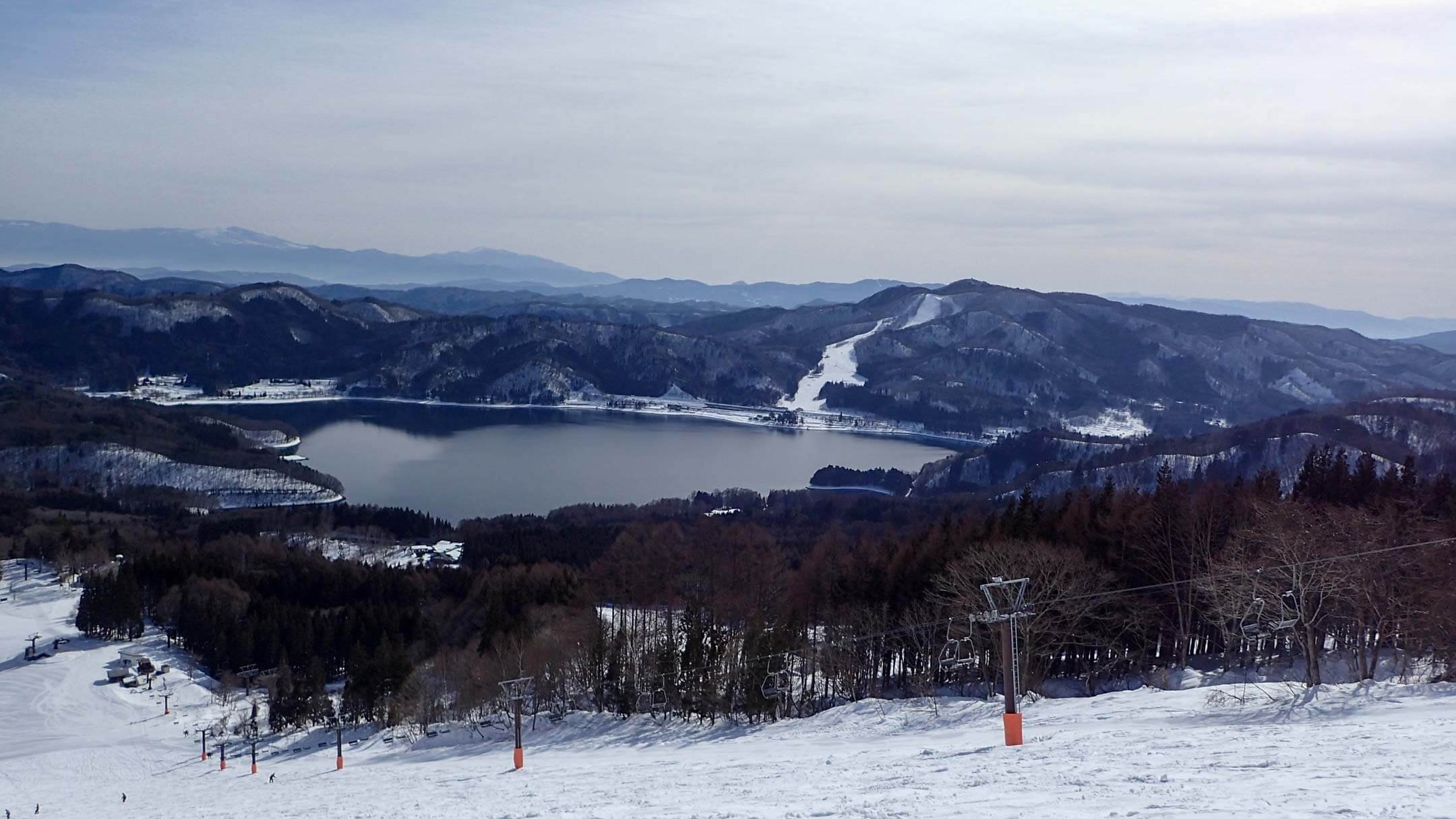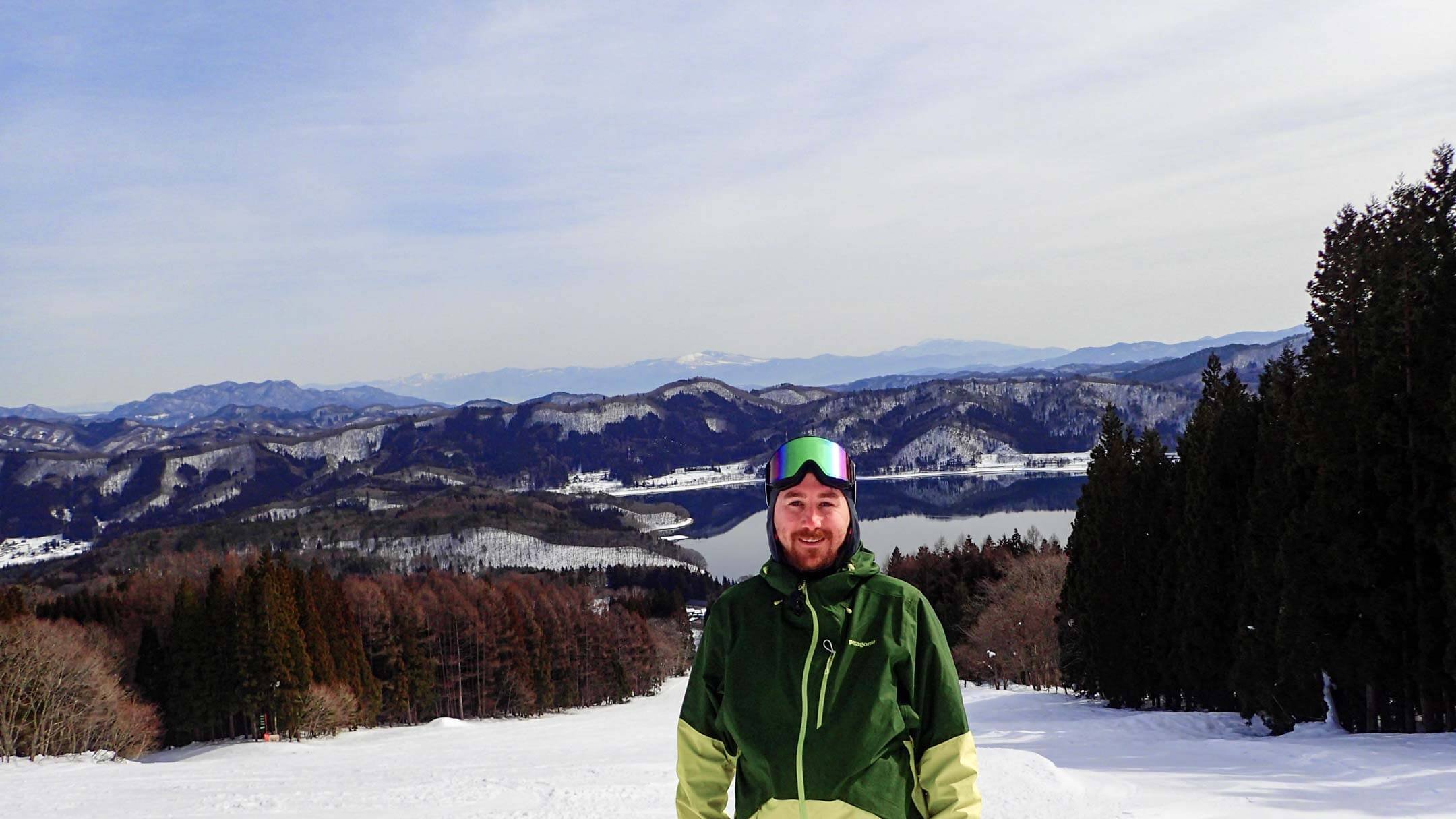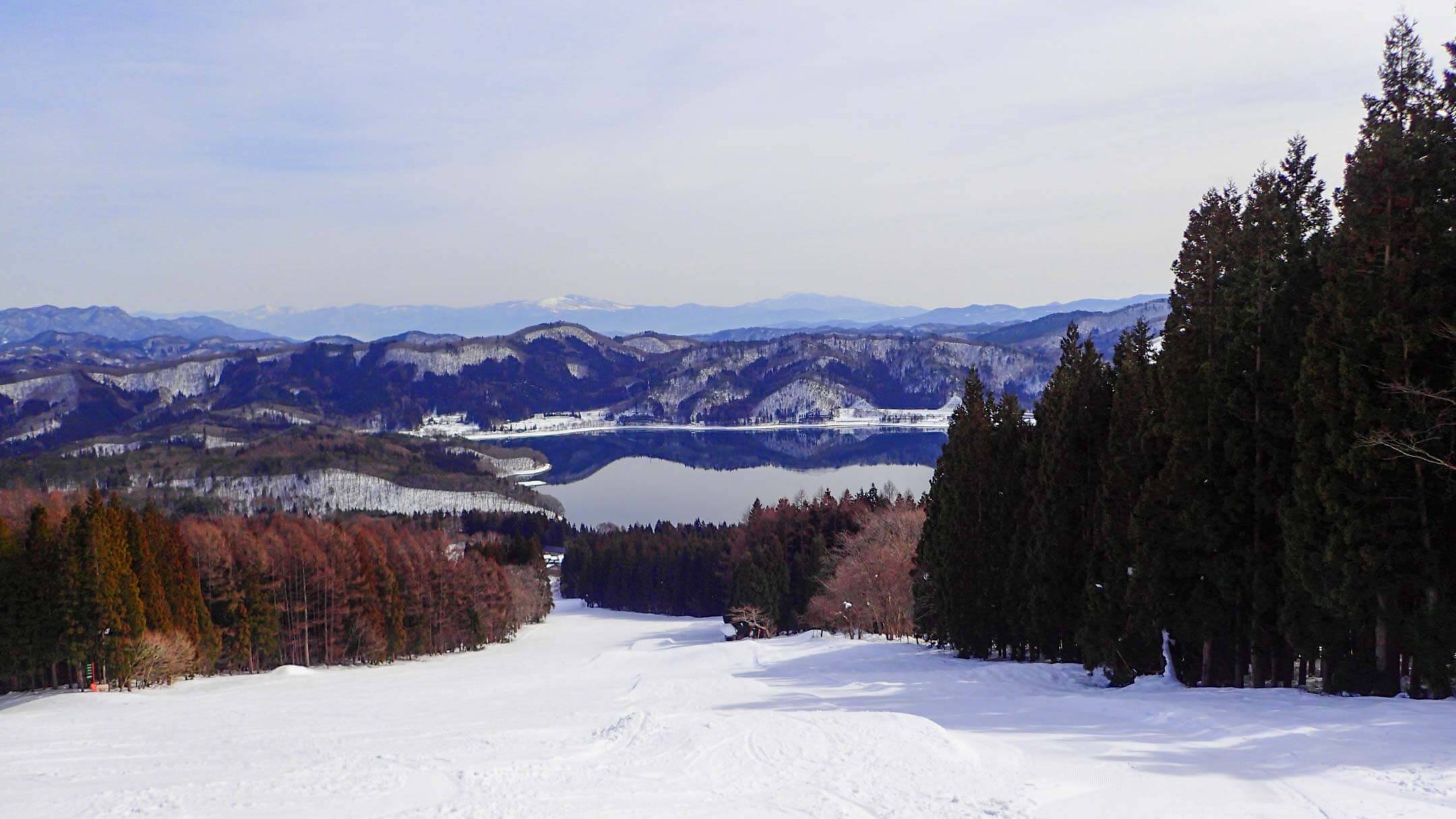Hakuba Cortina Ski Resort Guide
Hakuba Cortina is by far the best resort in the Hakuba Valley for those in search of steep and deep turns on a Japanese powder day. A combination of factors makes Hakuba Cortina ski resort the ultimate destination for those deep days, starting with the pitch of the trees. Unlike other Japanese resorts, Cortina opens its glades without restriction and this makes for an incredible experience. The steep pitch combined with the widely spaced trees makes this the pinnacle of a trip to Hakuba. Sadly, talk of the quality of Cortina’s tree riding is widespread meaning it is no longer a secret. This can result in some pretty big lift cues after a snowfall.
HAKUBA CORTINA FIRST IMPRESSIONS
Arriving at Cortina you at met by the sight of the iconic Green Park Hotel. A Tudor style hotel offering ski in ski out accommodation at Cortina. Most of the resorts facilities are inside the hotel, which can be pricey so if like me you are on a budget… bring your own lunch. Walking through the hotel to the slopes you will soon get a sense of excitement and anticipation, everyone is talking about getting in the lift line for the first lift.
Stepping outside the hotel you can be forgiven for thinking Cortina is a bit of nothing. There are three lifts at the base area which all run fairly slowly and it’s hard to get an appreciation for the terrain from the base area.
HAKUBA CORTINA SKI AREA
Similar to most Hakuba Valley ski resorts the terrain stats are nothing to get excited about, but who goes to Cortina to ride its 16 trails? Well, the Japanese, which is another reason it’s great because its best asset is mainly avoided by the locals. Cortina’s 16 runs sit mainly within a bowl and can be expanded if you consider that it is linked to neighbour Hakuba Norikura, but you will either need the Hakuba Valley Pass or a combined lift ticket to make use of this link.
There is some pretty decent beginner runs at Cortina however there are better Hakuba resorts to learn at. The real draw is the free ride zones including the backcountry lap that leads through to Norikura. The trees through these routes are well spread out, perfectly so! The combination of the well-spaced trees and the steep pitch makes Cortina an absolute must-visit resort.
The approach to off-piste at Cortina ski resort is different to the neighbouring Hakuba resorts. Most Hakuba resorts make you attend a course before you can ride in the dedicated off-piste zones. Hakuba Cortina is more relaxed and you are free to explore the terrain at your discretion. The tree-skiing at Hakuba Cortina is steeper, better and blessed with huge amounts of snowfall what’s not to love? Well, the one downside to skiing and snowboarding at Hakuba Cortina is that everyone knows how good it is. Be prepared to stand in lift queues but don’t worry, there is plenty of Japow to go around.
As mentioned above Hakuba Cortina ski resort is a small resort if you only take the trail map into consideration. Connected via lift to Hakuba Nortikura this opens more terrain including a fantastic backcountry route to Norikura through the trees from the top of the Number 4 chair.
BEGINNERS TERRAIN AT HAKUBA CORTINA
Cortina isn’t best known for its beginner ski and snowboard terrain but actually, it would be a decent place to learn your turns. The main beginner trail runs back down to the base area from the No. 1 chair and is a fairly long stretch. The beginner’s trail is nice and wide offering plenty of space for beginners to learn.
Also, what better place to learn than in a ski resort with copious amounts of snow, think about those soft landings.
INTERMEDIATE TERRAIN AT HAKUBA CORTINA
Intermediates will enjoy riding at Hakuba Cortina but should also consider adding the Norikura ski resort to their lift pass. A dual Cortina Norikura lift pass will open up more intermediate terrain. The Hiedayam Rinkan Course from the top of No. 4 chair allows intermediates to ski from the top of the resort dipping in and out of the trees within their comfort level.
ADVANCED TERRAIN AT HAKUBA CORTINA
Advanced skiers and snowboarders will have an absolute field day at Hakuba Cortina. The steep Hiedayama Courses are great but in reality, everyone is at Cortina for the trees. This is where Hakuba Cortina really stands out with its wide tree runs. Tree skiing at Hakuba Cortina is at your own risk and you should treat it with caution. If possible ride with a friend and bring the correct safety gear. Although the terrain is in bounds there is more snow than most skiers and snowboarders are used to so it wouldn’t be that difficult to run into trouble.
FREESTYLE TERRAIN AT HAKUBA CORTINA
There is no terrain park at Hakuba Cortina, but neighbour Norikura has a Pipe, a small terrain park as well as a boarder cross, and a mogul run. If freestyle is your thing then consider looking at these Hakuba Valley ski resorts; Hakuba 47, Tsugaike Kogen.
LIFTS AT HAKUBA CORTINA
Hakuba Cortina’s lift infrastructure can be quite frustrating. Seven lifts in total but none of them run particularly fast. Well, they do say good things come to those who wait and I can assure you that the run down is well worth the slow uplift. To access the more advanced terrain you will need to catch the No. 1 lift from the base area where you can then head up the No. 4 chair. There are normally long lift queues for the No. 4 lift on a powder day so if you are impatient then head to the No.5 chair which also accesses some incredible tree skiing.
HAKUBA CORTINA PROS
Hakuba Cortina ski resort has some of the best trees runs out of any resort I have visited. The combination of steepness, the spread of trees and the quality of snow all help this.
Hakuba Cortina and nearby Norikura receive more snow than the resorts closer to Hakuba village.
The quality of the snow at Hakuba Cortina is unrivalled in my experience.
Hakuba Cortina is one of the few resorts in Hakuba linked via chairlift to another. Ride between Cortina and Hakuba Norikura on the same day and explore both resorts.
Free shuttles are available to Cortina from the Happo Bus Terminal
HAKUBA CORTINA CONS
Hakuba Cortina Ski Resort is no longer a secret and due to the slow speed of the chairs, you can expect to spend 30-40 minutes in lift lines on busy days (it is more than worth it).
Despite having free transport it is not an enjoyable journey with the bus normally packed full. You will need to get the 7:30 am bus to make the first lift at Cortina Japan.
TRAVEL TO HAKUBA CORTINA SKI RESORT
Free shuttle buses run to Hakuba Cortina from the Happo Bus Terminal throughout the day. If you are planning to get first tracks, you will need to get the 7:30 am bus, but be warned this is incredibly popular so be early or you could miss out. This bus also stops at Tsugaike Kogen ski resort which is another favourite in Hakuba. Cortina is the furthest resort from Hakuba Village and the drive takes around 30 minutes.
HAKUBA CORTINA SNOW RECORD
Cortina gets the most snow out of all the Hakuba Valley ski resorts. 12m plus during the winter season! That is insane. Whether Cortina gets more snowfall or it catches the snowfall better with its bowl-shaped terrain matters not as the facts are as follows. The amount of snowfall that Cortina Hakuba receives is legendary and it is more than enough to blow your mind!
HAKUBA CORTINA LIFT PASSES
HAKUBA VALLEY PASS
If you are planning to visit more Hakuba Valley ski resorts than Hakuba Cortina it may be worth picking up a Hakuba Valley pass. The Hakuba Valley Pass not only offers access to the slopes but the interconnecting resort shuttles. This means your transport and skiing is included on the same pass. Find out more by watching the video below.
EPIC PASS
If you are an Epic Pass season pass holder than you will get access to the resorts of the Hakuba Valley included with your pass. The Epic Pass allows for 5 consecutive days of skiing in the Hakuba Valley, additional tickets can be purchased at a discount.
PAY AS YOU PLAY
If you want more freedom to choose your day to day activities and resorts you won't lose much money by paying on the day. Paying for your lift passes on the day offers a number of benefits. You can get full-day, morning or afternoon passes which offers flexibility.
MORE HAKUBA CORTINA VIDEOS
HAKUBA CORTINA GALLERY
To be fair I wasn’t stopping very often to take photos and in hindsight needing photos for a blog post that wasn’t that great an idea. But the conditions were insane so it was just go go go. These screenshots below should give a pretty decent idea about what to expect when snowboarding at Hakuba Cortina.
ACCOMMODATION AT HAKUBA CORTINA
If you have the money, a stay at the Green Plaza Hotel will leave you as close to the lifts as possible. A stay in this Tudor style hotel will cost around £200 per night. More likely is that you will stay in Hakuba Village and travel to Cortina when the forecast is good.
NEARBY RESORTS
FINAL THOUGHTS ON HAKUBA CORTINA
Hakuba Cortina brought me not only some of my best days on snow but also some of the best days of my life. Although there can be crowds (usually at No.4 chair) there is some great skiing and snowboarding to be had. The traverse left from the No. 5 chair before dropping into the trees is less crowded than other parts of the resort but has some great turns.
Tsugaike Kogen Ski Resort Guide
Tsugaike Kogen ski resort may still be the best-kept secret in the Hakuba Valley. Nicknamed ‘Powder Heaven’ but often overlooked by the more popular Happo One or Hakuba Cortina, Tsugaike Kogen is the place to go for uncontested powder turns.
One of 10 ski resorts on the Hakuba Valley Pass, Tsugaike Kogen ski resort is a Japanese ski resort that retains a local feel. Tsugaike receives an average of 12 metres of snow each winter season which makes it popular with snowboarders in search of fresh turns. Tsugaike Kogen lies along the same shuttle bus route as Hakuba Cortina and with most skiers opting to remain on the bus to its final destination, Tsugaike is the place to go to avoid lift lines on a powder day.
TSUGAIKE KOGEN FIRST IMPRESSIONS
Tsugaike has its own village with a number of hotels, pensions, restaurants and rental shops. As you approach you can tell that you are somewhere with a different feel to Happo. Tsugaike is pretty subdued in terms of its nightlife or apres scene and it’s clear that people are here for one reason and one reason alone… the powder.
Queuing for the bottom gondola at Tsugaike you see powder chasers with wide-waisted skis and fat snowboards adorning swallowtails. This sets the tone for what to expect. Taking the gondola from station one to the mid-station leaves little to get excited about for more advanced skiers and snowboarders. But from the mid-station to the top station, the gondola hovers over the famed DBD tree riding zone. It is from here that you can see why people flock in search of Tsugaike's famous well-spaced trees.
TSUGAIKE SKI AREA
Having spent more days snowboarding at Tsugaike ski resort than any other Hakuba resort on my trip, it’s hard to argue against it being my favourite as I kept going back. The Tsugaike Kogen tree access is the main draw with the DBD offering everything from quite mellow terrain at the top of gate 1 to steeper runs through gates 3, 4 and 5.
The terrain at Tsugaike Kogen is divided into two main zones, upper and lower Tsugaike. The total vertical drop of Tsugaike ski resort is over 900m which is great when considering the size of other local resorts. Tsugaike Kogens highest point is about 1700m.
TSUGAIKE LOWER MOUNTAIN
The lower mountain at Tugaike Kogen includes anything found beneath the mid-station of the gondola. The majority of this terrain is mellow beginner’s terrain with 5 short chairlifts and the gondola accessing beginner’s trails to the base. The lower mountain at Tsugaike Kogen would make an ideal place to learn with the mellow terrain feeling the opposite of intimidating.
TSUGAIKE UPPER MOUNTAIN
There are still entry-level green pistes on the upper mountain and this is one of the reasons why Tsugaike is so popular with beginners. If learners are feeling confident enough to take the gondola to the upper mountain then the winding green course through the forest makes an exciting edition for beginners.
The upper mountain however is mostly home to the intermediate and advanced terrain at Tsugaike Kogen ski resort. The pinnacle of this is the Tsugapow DBD courses. In this area, there are five separate gates that you can take to enter the designated tree-skiing zones. If the snow conditions are good then this area is unrivalled and is one of the best zones I have ever snowboarded in.
In addition to the DBD Tsugaike Kogens upper mountain has a number of red-graded terrain and one black (Horseback Course). The upper mountain is also home to TG Parks, Tsugaikes freestyle terrain. The terrain park at Tsugaike is well worth a visit and has the benefit of running underneath the No.3 Quad Lift.
BEGINNERS TERRAIN AT TSUGAIKE KOGEN
The lower mountain at Tsugaike Kogen is perfect for beginners. All of these runs are wide, mellow slopes that have suitable lift access.
On the upper mountain, there is an interesting green trail that winds its way along a Cat Track trough the Tsugaike trees.
INTERMEDIATE TERRAIN AT TSUGAIKE KOGEN
The upper mountain consists of mainly intermediate terrain. There are a couple of long red-graded pistes with the steeper Champion slope also of note.
ADVANCED TERRAIN AT TSUGAIKE KOGEN
Advanced skiers and snowboarders will love the tree skiing found in the Tsugaike Double Black Diamond gates. To access this area you need to take a course (more info follows in this post).
Also of note is the run Uma no see which follows a narrow ridgeline.
FREESTYLE TERRAIN AT TSUGAIKE KOGEN
Tsugaike Kogen has 2 terrain parks which is fantastic for a Japanese ski resort. The main Tsugaike Park is decent and is one of the longest in the Hakuba Valley. The parks consist of jumps, rails and lots of great side hits and banks.
TSUGAIKE DOUBLE BLACK DIAMOND GATES
To access the Double Black Diamond or DBD you will first need to attend a safety lecture, sign a disclaimer and then collect your armband. The courses run out of Jacky’s kitchen, a diner near the top lift station. It’s best to head to Jacky’s Kitchen early so that you can beat any rush on a powder day.
The DBD course provides you with information about local hazards within the designated tree-riding zone and although many skiers I spoke with found it pointless, I appreciated the extra safety precautions. The courses are run by local skiers who ride at Tsugaike Kogen regularly, their first-hand knowledge was useful.
In the Tsugaike DBD there are five gates. Gate 1 is closest to the chairlift and offers the easiest terrain. In fresh snow plenty of fun can be had in gate 1 without heading into the more challenging areas. The remaining 4 gates access terrain with more hazards such as cliffs. The DBD area is an incredible place on a powder day!
TSUGAIKE KOGEN PISTE MAP
TSUGAIKE KOGEN SKI PASSES
The Hakuba Valley lift pass is valid at Tsugaike Kogen and may represent your best option if you want to explore more than one Hakuba ski resort.
As a beginner, you can purchase a lower mountain lift pass at a discounted rate. This beginner’s lift pass will allow you access to the base area lifts and some very mellow green terrain.
Tsugaike and the Hakuba Valley is also valid on the somewhat controversial Epic Pass from Vail Resorts. Personally, I love the Epic Pass and have made many videos about it in the past.
If you just want to pay as your play then a 1 day lift pass at Tsugaike will cost around 5000 Yen.
LIFTS AT TSUGAIKE KOGEN
The main lift you will use at Tsugaike Kogen is the gondola which links the base area with the top of the resort. The gondola journey takes a while but it is travelling a fair distance in the process. Actually, after the leg-burning tree runs a long rest in the gondola was quite welcoming.
Tsugaike has a further 9 high-speed chairs and some that are much slower… 19 lifts in total service the resort although only the lower mountain is open for night skiing.
SEASON DATES TSUGAIKE KOGEN
Tsugaike Kogen has a long season opening the resort in mid December and remaining open until the beginning of May.
TSUGAIKE KOGEN SNOW RECORD
Tsugaike Kogen is located in Northern Hakuba at the snowiest end of the valley. The resorts in this region get absolutely pounded with snow and Tsugaike Kogen averages 12m of snowfall every winter. This means the top of the resort and tree skiing gets ample amount of snowfall for any powder skier.
VILLAGE AT TSUGAIKE KOGEN
Despite Tsugaike having a quieter village than Happo, it is fair to say that it has been commercialised. You will find a high ropes course on the slopes and fast food restaurants surrounding the mid-gondola station. This isn’t necessarily a bad thing but won’t be to everybody’s taste. A popular stop at the end of a day on snow is the bar near the base gondola station. You will recognise it from its uniquely Japanese foot spa, the perfect way to rejuvenate your feet at the end of a day on snow.
TSUGAIKE KOGEN PROS
Tsugaike Kogen receives an abundance of snow! 12m on average per season.
Tsugaike tree skiing is fantastic and although you have to take a course to enter this isn’t too much hassle.
Despite the combination of a great snow record and incredible tree skiing, Tsugaike is much less crowded than the nearby Hakuba Cortina resort.
Getting to Tsugaike ski resort is really simple using the Hakuba Valley shuttle buses that are provided free with your lift pass.
Tsugaike is great for beginners and provides English instruction through their snow sports school.
Due to transport links, it is easy to ski at Tsugaike and the resorts of Iwatake, Norikura or Cortina on the same day.
TSUGAIKE KOGEN CONS
On-piste skiing at Tsugaike is fairly mellow so may not suit a more able skier or snowboarder
Night skiing at Tsugaike Kogen is available but only accesses the beginner terrain which is quite dull.
Taking the course to enter the DBD area will take up some valuable on snow time and you will need to wear an armband each time you wish to enter the trees.
TRAVEL TO TSUGAIKE KOGEN SKI RESORT
Tsugaike is easily reachable from all main transport hubs in Hakuba with regular shuttle buses running throughout the day. Tsugaike ski resort is further out of Hakuba than some of the other resorts with the journey taking between 20-30 minutes depending on conditions.
The resort of Tsugaike Kogen is located between Iwatake and Norikura ski resorts. This makes it perfectly placed to be able to ski at more than one Hakuba resort on the same day. The resorts are linked by shuttles and this makes navigating the area fairly straightforward.
ACCOMMODATION AT TSUGAIKE
Tsugaike Village is an option for accommodation close to the slopes in Hakuba. Staying in the village would represent a more laid-back option where you can get away from the more western restaurants and bar scene. Be aware that around Tsugaike it is likely that you will encounter less spoken English and not every shop or restaurant will accept credit cards.
Alternatively, you can stay closer to the main hubs and commute to Tsugaike on the days that you would like to ski or snowboard there. I stayed at Nori’s sharehouse, which is a no-frills share home in the Hakuba Village. The location was good and I had no complaints about my stay. The house even had a workstation to tune your gear. There are plenty of other accommodation options in and around Hakuba
TSUGAIGE KOGEN VIDEOS
ACTIVITIES AT TSUGAIKE KOGEN
In addition to skiing and snowboarding at Tsugaike Kogen there are many other ways to stay entertained. The high ropes course at mid-mountain will be popular with families and children, as will the tubing area.
A Japanese ski holiday wouldn’t be complete without a trip to a local Onsen. At Tsugaike there are a coupe of Onsens in the village that you can visit after your day on snow.
NEARBY SKI RESORTS
FINAL THOUGHTS ON TSUGAIKE KOGEN SKI RESORT
Tsugaike featured regularly in my discussions when choosing which resort I wanted to ride at during my trip. I really enjoyed the DBD trees area but sadly on a couple of occasions, this area was closed. For me when the DBD was closed there wasn’t enough to keep me entertained so I would normally take a bus to another resort. When the DBD was open Tsugaike represents one of the best tree skiing zones in the Hakuba Valley.
A Guide To Snowboarding In The Hakuba Valley Japan
When people are writing lists of their dream ski and snowboard experiences Japan is never far from the top. The Hakuba Valley and its 10 unique ski areas may just be amongst the most sought-after ski experiences in the world. Nestled within the heart of the Japanese Alps, the Hakuba Valley has rightfully earned its reputation as a premier destination for skiers and snowboarders seeking pristine powder, breathtaking landscapes, and a unique cultural experience. If you're a winter sports enthusiast looking for your next adventure, here's a comprehensive guide to skiing in the Hakuba Valley.
Powder Days at Hakuba Cortina ski resort
HAKUBA’S MAIN INGREDIENT
When choosing your ski destination there is one really important ingredient that surpasses all other requirements, snow! Without snow, it’s not a ski holiday. Luckily for the Hakuba Valley, it just may be amongst the snowiest destinations on earth. Hakuba gets blanketed in fresh snow between December on April, with an incredible average of 12m per winter. This incredible snow record combined with the diverse terrain on offer within the Hakuba Valley makes it an exceptional place to ski and snowboard.
ABOUT THE HAKUBA VALLEY
The Hakuba Valley is a combination of 10 ski resorts set amongst the beautiful backdrop of the Japanese Alps. The 10 Hakuba Valley ski areas are all included on the same lift pass making it really easy for skiers and snowboarders to navigate the different resorts. The real beauty of this combined ski area is found in the variety of the terrain, ensuring that everyone, expert through beginner has somewhere suitable to ski for their ability.
IF YOU FIND VALUE IN THIS POST CONSIDER CLICKING THE BUYMEACOFFEE LINK BELOW TO SUPPORT MY CONTENT
GETTING TO THE HAKUBA VALLEY
The Hakuba Valley is located on Japan’s main Island Honshu. Easily accessible from the major cities of Tokyo and Nagoya, there are options to visit Hakuba by train, bus, or private car. The closest airport to the Hakuba Valley is Tokyo’s Narita airport where you can catch a direct coach or the fast trains via Nagano.
TRAIN
Popular with many visitors to Japan a trip on the fast Japanese railway is well worth doing. From Tokyo, you will want to board the Hokuriku Shinkansen (Bullet Train) destination, Nagano. This section of the journey takes 1.5-2 hours.
In Nagano transfer train to the Oito Line destination Hakuba Station. This one-hour train ride drops you in the centre of Hakuba where regular buses run. From here it is also possible for many accommodations to collect you.
When travelling by train be sure to take advantage of the luggage transfer option direct from Tokyo Airport to your Hakuba accommodation. Baggage transfer can be arranged via the counters in the arrivals area and normally takes 24 hours. Expect to pay around 2000 yen per bag but this is weight dependent.
BUS
The easiest least fuss way to reach Hakuba is by bus directly from the airport terminal. Services are available from both Tokyo Narita and Tokyo Haneda Airports. I booked with Nagano Snow Shuttle who I would recommend. The service provided by Nagano Snow Shuttle was excellent with coach transport into Hakuba Echoland and small mini bus transfers direct to my apartment.
BEST TIME TO VISIT THE HAKUBA VALLEY
The ski season in the Hakuba Valley typically runs from December to April. The region receives abundant snowfall, making it a haven for skiers. The best time to visit is usually January and February when the snow is at its peak, and the conditions are perfect for skiing.
SNOW CONDITIONS
The primary reason snowboarders flock to the Hakuba Valley is the exceptional quality of snow. The area receives a generous amount of snowfall from late November to early April, creating the perfect canvas for shredding the slopes and finding freshies in the epic trees. The peak snow conditions are typically seen between mid-December and mid-February. During this time, the valley is blanketed in a thick layer of powder, offering the best opportunity to score some Japow! The Hakuba Valley has an average snowfall of 12m per season with the resorts of Tsugaike and Cortina benefiting the most.
CROWDS AND ATMOSPHERE
The winter months of December and January tend to attract more tourists due to the ideal snow conditions. While this is great for the vibrant atmosphere and the chance to meet fellow snowboarding enthusiasts, it also means more crowded slopes and busier accommodations. If you prefer a quieter experience with fewer people, consider visiting in late February or March. These months offer a good compromise between great snow conditions and a more serene environment. You can always get away from the crowds in Hakuba with resorts like Sanosaka which are far further from the main village and the mega-resort of Happo One.
WEATHER CONSIDERATIONS
While the Hakuba Valley is renowned for its consistent snowfall, weather conditions can still influence your snowboarding experience. January tends to be the coldest month, with temperatures potentially dropping to sub-zero levels. On the other hand, March offers milder weather, longer daylight hours, and a higher chance of bluebird days, which are perfect for capturing stunning photos against the backdrop of the Japanese Alps.
EVENTS AND FESTIVALS
To add an extra layer of culture to your snowboarding trip, consider timing your visit with one of the valley's events or festivals. The Hakuba Snow Festival, typically held in February, features spectacular light displays and cultural performances. This provides an opportunity to immerse yourself in the local culture while taking a break from the slopes.
EARLY VS LATE SEASON
The beginning and end of the snowboarding season in Hakuba each have their own appeal. Early season, from late November to early December, offers the chance to catch the first powder runs of the year. While the snow cover might not be as deep as later in the season, you can take advantage of fewer crowds and sometimes discounted rates on accommodations and lift passes. The late season, from late March to early April, brings warmer temperatures and the potential for spring skiing conditions. It's a great time for enjoying sunny days on the slopes and taking advantage of end-of-season deals.
In conclusion, the best time to visit the Hakuba Valley for snowboarding largely depends on your preferences and priorities. If you're seeking pristine powder and a vibrant atmosphere, the heart of the winter season from mid-December to mid-February is your ideal window. However, if you value quieter slopes, milder weather, and potential cultural experiences, late February to March might be more your speed. Whichever time you choose, the Hakuba Valley promises an unforgettable snowboarding adventure amidst breathtaking natural beauty.
HAKUBA VALLEY SKI RESORTS
The Hakuba Valley in Nagano, Japan, is a paradise for ski and snowboarding enthusiasts, boasting a collection of ten diverse and captivating ski resorts that together form the Hakuba Valley Pass. This pass offers visitors access to an array of slopes, terrains, and experiences, making it a sought-after destination for winter sports enthusiasts from around the world.
When visiting the Hakuba Valley you can base yourself at one resort or make the most of the Hakuba Valley ski pass to visit as many of them as possible. Here is an overview of the ten Hakuba Valley ski resorts but if you require more information please check out the resort guides.
HAPPO ONE SKI RESORT
Happo-One is the largest and most famous resort in the valley, renowned for hosting downhill events during the 1998 Winter Olympics. With over 1,000 meters of vertical drop and a wide range of runs catering to all skill levels, it's a popular choice for both beginners and advanced skiers. Its bustling village features numerous accommodations, restaurants, and après-ski options.
Happo is the most popular ski resort in the Hakuba Valley and as such can fall foul of crowding during peak periods. Happo One ski resort offers the closest access to the village amenities so is the hassle-free option for Hakuba Valley skiing.
Happo One is famous for its backcountry terrain with many skiers and snowboarders alike visible from the highest lifted point heading into the backcountry.
HAKUBA GORYU SKI RESORT
Hakuba Goryu snow resort offers an ideal blend of terrains for all levels, from gentle slopes for beginners to challenging steeps for advanced skiers. The resort is also famous for its family-friendly atmosphere with Goryu village and base area a great place to stay for families. Its interconnected slopes with Hakuba 47 allow skiers to explore a variety of trails and enjoy stunning panoramic views.
Hakuba Goryu is easy to access from the main Hakuba Village with regular bus services available from Echoland, Hakuba station and the Bus Terminal. The majority of the terrain at Hakuba Goryu is best suited for beginners however, there are some challenging areas such as the adventure course.
HAKUBA 47 WINTER SPORTS PARK
Adjacent to Goryu, Hakuba 47 boasts exceptional snow conditions and a reputation for its excellent tree skiing and powder zones. It's a haven for freestyle skiers and snowboarders, thanks to its extensive terrain park with various jumps, rails, and features.
Hakuba 47 is linked to Hakuba Goryu so you can ski between the resorts throughout the day. Hakuba 47 is best known for its large terrain park which is one of the best in the Hakuba Valley. Hakuba 47 has a dedicated tree-riding zone so be sure to sign up for the Double Black Diamond Club when you arrive at the resort.
TSUGAIKE KOGEN SKI RESORT
Tsugaike Kogen is known for its vast area and long, wide slopes that cater primarily to beginners and intermediates. Its serene mountain environment and abundance of ski-in, ski-out accommodations create a tranquil experience. The upper areas provide more challenging terrain for those looking to improve their skills.
Tsugaike is a freeride haven with some of the best tree-skiing possible in the Hakuba Valley. To access the Tsugaike tree area called the DBD (Double Black Diamond) you must attend a free safety course. Tsugaike gets dumped on and this makes the tree skiing at Tsugaike some of the best in the area. Head to Tsugaike to chase powder turns without crowds.
IWATAKE SNOW FIELD
Iwatake Snow Field is an excellent choice for families and beginners, offering gentle slopes and relaxed surroundings. The panoramic vistas of the Northern Alps add to the resort's charm. It also features the Iwatake Snow Park for those interested in terrain park features.
Iwatake is a mere 10 minutes from the Hakuba station so accessing the resort is easy using the free shuttles. Once dropped at the gondola, Iwatake has mellow slopes on the lower mountain and more challenging terrain on the upper mountain. The best skiing and snowboarding at Iwatake can be found in the four tree areas near the SkyArc restaurant. From here you can find powder stashes for days after fresh snow.
HAKUBA CORTINA SKI RESORT
Cortina is celebrated for its heavy snowfall and stunning alpine scenery. Its challenging and varied terrains, including gladed areas and steep descents, make it a favourite among advanced skiers and snowboarders. The off-piste opportunities and deep powder runs are highlights of this resort.
Hakuba Cortina is more open-minded regarding its tree skiing than other Japanese resorts with no safety course needed to make the most of its wooded areas. Cortina tree-skiing is considered amongst the best in the world so it is no longer a secret. You may need to wait in line to score those Cortina powder turns but I can assure you it is worth the wait.
Make sure you take the backcountry run from the top lift that heads through the trees and across to the neighbouring ski resort Hakuba Norikura Onsen. This run was not just a favourite of my trip but also one of my favourite runs at any ski resort.
NORIKURA ONSEN SKI RESORT
Norikura Onsen is a quaint resort known for its natural hot springs and relaxed atmosphere. While it offers a mix of trails for different skill levels, it's especially suitable for those seeking a tranquil skiing experience away from the crowds.
Norikura really is the essence of what Japanese skiing should be. This local-focused resort has resisted the urge to pander to international tourists maintaining an authenticity lost in busier Hakuba ski resorts. The local area at Norikura Onsen is varied enough to keep the family entertained, with boarder cross, half pipe and a moguls course added for fun!
KASHIMAYARI SKI RESORT
Kashimayari stands out for its serene setting and excellent snow quality. It caters to a wide range of abilities with a mix of groomed trails and off-piste options. The resort's focus on nature and relaxation is perfect for families and those looking for a peaceful escape.
Kashimayari is disconnected from the main Hakuba village meaning accessing the resort takes longer and there are less frequent services. Although this may sound like a negative it actually plays into Kashimayari’s favour as if you make the journey you will be certain to have a more serene experience.
HAKUBA SANOSAKA SNOW RESORT
Hakuba Sanosaka is favoured for its family-friendly environment and affordable pricing. The resort's slopes cater mostly to beginners and intermediates, and its relaxed atmosphere is perfect for those seeking a laid-back skiing experience.
The views from Sanosaka over Lake Aokiiko are a highlight of snowboarding at Sanosaka. The views combined with empty pistes ensure that Sanosaka will remain one of my Hakuba highlights.
Lake down trail at Sanosaka is one of my TOP 5 HAKUBA VALLEY SKI RUNS.
JIGATAKE SKI RESORT
Jiigatake offers a more off-the-beaten-path experience, with fewer crowds and a focus on natural beauty. While its ski terrain is limited compared to larger resorts, it's a great option for those looking to enjoy the tranquillity of the mountains and explore less-travelled slopes.
WHERE TO STAY IN HAKUBA
With the variety of ski resorts and village bases on offer in the Hakuba Valley where to stay can become quite the headache. In the next section of the Hakuba Valley Guide, I will provide you with an overview of the main areas you could stay at on your visit to the Hakuba Valley.
HAKUBA VILLAGE
The central hub of the valley, Hakuba Village offers a mix of accommodations, dining options, and entertainment. This area is perfect for those who want easy access to the slopes as well as the convenience of nearby amenities. Hakuba Village provides a good balance between the buzzing energy of a resort town and the tranquillity of the mountains.
By staying in Hakuba Village you guarantee good transport links to all Hakuba Valley ski resorts and shops and amenities within walking distance.
HAPPO ONE
Happo-One is not only a popular ski resort but also a prime location to find lodging. Offering a variety of ski-in/ski-out accommodations, it's an ideal base for skiers and snowboarders who want to maximize their time on the slopes. The area boasts stunning views of the iconic Happo-One mountain and is surrounded by cosy restaurants and shops.
Staying at Happo One provides direct access to Hakuba’s largest ski area. The downside to residing in this area is that you will find it busier, but for some this will be a positive with access to plenty of bars and restaurants.
GORYU & 47
These interconnected resorts provide a wide range of accommodations suitable for families, couples, and solo travellers. With convenient access to the slopes and a friendly atmosphere, Goryu and Hakuba 47 are great choices for those looking for a relaxed stay while still having plenty of outdoor activities at their doorstep.
By staying close to Goryu and Hakuba 47, you guarantee close access to two ski resorts within the Hakuba Valley with accommodation within walking distance from the lifts. Additionally, ski resorts elsewhere in Hakuba have fantastic links to Goryu & 47 so if you want to be able to access all resorts but from a quieter village, this could be your best option.
ECHOLAND
If you're seeking a vibrant après-ski scene and a variety of dining and entertainment options, Echoland is the place to be. Situated just a short distance from the ski resorts, this area offers a mix of boutique hotels, guesthouses, and lodges. It's a fantastic option for those who want to unwind after a day on the slopes with lively nightlife and a diverse culinary scene.
Echoland is ideal for those who want to be amongst the thick of the action. Whether it is access to the resorts, buzzing bars or access to western or local cuisine, Echoland makes a fantastic base.
TSUGAIKE KOGEN
For a quieter and more secluded experience, Tsugaike Kogen provides a serene atmosphere away from the bustling crowds. The accommodations here range from traditional Japanese ryokans to modern lodges. This area is ideal for those looking to connect with nature and enjoy a peaceful escape.
Basing yourself in Tsugaike can feel disconnected from the main Hakuba Village however, this is overcome by being in the midst of the best powder in the valley. The area close to Tsugaike and Cortina gets the best snow in Hakuba and as such staying here means you are closer to being first in the lift lines.
CORTINA
If you live for deep snow, consider staying near Cortina. Known for its heavy snowfall, this area attracts avid skiers and snowboarders looking to explore the Cortina tree runs. Cortina offers limited accommodations, but its unique terrain makes it a must-visit destination for serious winter sports enthusiasts.
If searching out powder is your only concern than staying at Cortina could represent a good option. Cortina is linked to Norikura via slopes so it is possible to ski at both resorts. Furthermore, Cortina has good links to Tsugaike meaning Tsguapow is around the corner.
The negative to staying in Cortina is that you will have less choice in accommodation and fewer options for food and activities after the lifts have closed.
No matter where you choose to stay in the Hakuba Valley, you'll be treated to breathtaking scenery, incredible snow conditions, and warm Japanese hospitality that will make your trip unforgettable. Remember to book your accommodations well in advance, especially during the peak winter months.
IF YOU FIND VALUE IN THIS POST CONSIDER CLICKING THE BUYMEACOFFEE LINK BELOW TO SUPPORT MY CONTENT.
APRES SKI AND ACTIVITES
Away from the world-class skiing and snowboarding Japanese culture is a major attraction for skiers to visit the Hakuba Valley. Après ski in the Hakuba Valley may look different to what you may be used to in European ski resorts… Let's take a dive into Japan’s after-ski culture.
ONSENS
One of the highlights of après ski in Hakuba is the opportunity to soak in the region's renowned onsens (natural hot springs). The warm, mineral-rich waters provide the perfect way to soothe tired muscles and reinvigorate the body. Many accommodations in the area feature private or communal onsens, where you can immerse yourself in the serene ambience of snow-covered landscapes while enjoying the therapeutic benefits of the water.
DINING OUT
Hakuba's après ski scene also features an array of dining options that cater to diverse palates. You can savour traditional Japanese cuisine, including hearty bowls of ramen and fresh sushi, or opt for international flavours. It will sound uncultured but I think I had the best Kebab of my life (Samurai Kebab) in Hakuba which was just what I needed at the time.
One of my favourite things about the Hauba Valley is the many snack stalls at the base of each resort, there is always a vendor offering something incredible for the pallet.
Crepe bought at Goryu base area.
BARS AND CAFES
The drinking scene in Japan is not the same as in Europe but don’t let that fool you into thinking it doesn’t exist. There are hundreds of bars and restaurants in the Hakuba Valley with a good mix of everything, including a hidden speakeasy in a cigarette vending machine.
During my time in the Hakuba Valley, I enjoyed the atmosphere and food at Blizzard before heading to Happo One For Night Skiing and the foot onsen bar at the base of Tsugaike. Both of these spots are completely contrasting so there will always be somewhere to fit your mood!
CULTURAL EXPERIENCES
For those interested in delving into Japanese culture, Hakuba offers a chance to explore beyond the slopes. You might engage in traditional tea ceremonies, learn about local crafts, or even participate in snow festivals that celebrate the magic of winter. I enjoyed exploring various temples around the village as well as visiting the Snow Monkeys.
FINAL THOUGHTS
Snowboarding in the Hakuba Valley is one of the highlights of my life, not just my snowboard journey. The rich blend of incredible snow, interesting resorts, and an ancient culture moulded this into a unforgettable experience.
If you have any questions or would like help planning your trip to the Hakuba Valley consider booking a Trip Planning session.
Japanese Snow Monkeys Experience
Nestled in a serene ravine in the northern part of Nagano Prefecture lies Jigokudani Yaen Koen, the Snow Monkey Park, where a troop of Japanese macaque monkeys has been captivating visitors since 1964. This unique attraction allows you to observe these playful primates up close, especially during the winter months when they indulge in the comforting warmth of the natural hot springs.
GETTING TO THE JIGOKUDANI MONKEY PARK
Although the monkeys inhabit remote mountainous areas, reaching the Snow Monkey Park is feasible with the convenience of buses running from popular destinations like Nagano (40 minutes), Nozawa Onsen (30 minutes), Shiga Kogen (30 minutes), Yudanaka, and Shibu Onsen (10 minutes) to Kanbayashi Onsen. From there, embark on a picturesque 25 to 40-minute forest trail walk to the park, which remains accessible year-round.
My journey started in Hakuba where I took a bus 2 hours directly to the start of the walk to the snow monkey park. The bus journey cost 3900 YEN which is equivalent to around £27. The bus departed from the Happo Bus Terminal and tickets could be purchased inside the bus station.
WALKING TO THE SNOW MONKEY PARK
Regardless of your journey’s origin, you will be dropped at the Snow Monkey Park bus stop in the village of Kanbayashi Onsen. From the bus stop, you will walk uphill towards the start of the trail to the snow monkey park.
In total, the walk to Snow Monkey Park will take 30-40 minutes and cuts through beautiful woodland. Due to the popularity of the Jigokudani monkey park, this path is well trodden, although depending on your footwear you may wish to hire spikes (1350YEN) in winter at the bottom of the trail.
The trail from the car park is 1 mile in length and winds through the forest. The path is mostly flat although may be covered in snow. To access the park, the path leads to a steep staircase which is inaccessible to wheelchair users.
During the winter, the path will be covered in snow and ice. Heavy snowfall is a regular occurrence in this region of Japan so dressing appropriately should be a high priority. Temperatures can drop below -10°C and if required snow suits can be hired from the gift shop at the start of the trail.
Rental from the gift shop can not be booked in advance and are therefore subject to availability and demand. Renting boots will cost 800YEN whereas a warm winter jacket will cost 500YEN.
Japanese macaques, fondly known as snow monkeys, boast the northernmost range of any non-human primates in the world. The park is also called the Jigokudani Monkey Park or the Jigokudani Yaen Koen.
JAPANESE WILDERNESS
The Jigokudani Monkey Park is an escape from the usual hustle and bustle of Japanese cities. Situated along the Yokoyu River in the Shiga Kogen foothills, Jigokudani is a welcome change to the pace of life in Japan. The woodland and park are draped in snow throughout the winter and the rugged terrain and geothermal activity combine to make this a unique landscape. Here, amidst the lush forests and towering mountains, multiple troops of monkeys, totalling in the hundreds, call this enchanting place their home.
Established as a facility in 1964, Snow Monkey Park offers a unique opportunity to observe Japanese macaques in a natural environment without cages or fences. Beyond this, it serves as an educational platform, allowing visitors to learn about primate behaviour while contributing to keeping the monkeys away from neighbouring farmlands. The park staff provides daily meals to the monkeys, ensuring they frequent the area year-round.
JIGOKUDANI SNOW PARK ETIQUETTE
For the protection of the monkeys and their habitat, it is important to follow the park's rules during your visit. It is requested that you do not feed the monkeys. The more that visitors feed the monkeys this can lead to unwanted encounters or monkeys trying to steal food from visitors. You should keep your distance from the monkeys allowing them space and ensure you avoid eye contact. Eye contact to the monkeys can be seen as an act of aggression so should be avoided.
MONKEY BATH TIME
The highlight of Snow Monkey Park is witnessing the monkeys bathing in the soothing hot springs during winter. The best time to witness this captivating sight is between December and March. The macaques follow their own rhythms and bathe freely, moving between the different baths ensuring everyone can get a good view.
On my visit, I was blown away by the amount of monkeys present in the baths. A good rule of thumb for me was to move to an area where no monkeys were currently bathing. This meant you could find a prime position for when they eventually left the crowded pools and opted for a more secluded experience.
Observing the monkeys bathing, you could see clearly the hierarchy and family grooming processes that the Japanese Macaques abide by.
FINAL THOUGHTS
For me, this visit was a highlight of my trip to Japan. Despite being a two-hour bus ride away from Hakuba I would say the visit is very much worth it. Jigokudani Yaen Koen promises an unforgettable encounter with the snow monkeys, offering a glimpse into the beauty of their natural habitat. Witnessing these macaques soaking in the hot springs amidst picturesque surroundings is a truly awe-inspiring experience.
Hakuba 47 Ski Resort Guide
Hakuba 47 ski resort is a year-round resort that offers skiing and snowboarding during the winter and mountain biking during the summer months. Hakuba 47 is one of the few linked ski areas in the Hakuba Valley and you can ride via chairlift between Hakuba 47 and the nearby Hakuba Goryu ski resort. Hakuba 47 offers more advanced terrain than its neighbour with some steep runs but most impressive is its well-maintained terrain park.
HAKUBA 47 SKI RESORT FIRST IMPRESSIONS
Snowboarding between Hakuba 47 and Hakuba Goryu is a nice change of pace. Normally in the Hakuba Valley, you will need to take shuttle buses to ride between the resorts, but not here. Linked via shared runs and lifts, it is possible to ski both of these resorts in one day. The Hakuba 47 side of the ski resort has a beautiful red run that runs from the top of Quad Chair C, back to the base of the gondola. From the gondola, you can see why Hakuba 47 is so popular with freestyle skiers and snowboarders. The terrain park here has a small half pipe as well as a large, medium and small line of jumps and features.
HAKUBA 47 SKI AREA
Japanese ski resorts are not known for having lots of skiable terrain but when considering Hakuba 47 without its neighbour you are left with 8 trails and a half-pipe. The skiable terrain at Hakuba 47 increases when you consider the interconnected trails shared with Hakuba Goryu. The terrain at Hakuba 47 will appeal to intermediates and experts more than beginners. Beginners should consider the runs near the base of Goryu ski resort which has mellow beginner-friendly pistes.
The main draw to Hakuba 47 is the terrain park. Located next to the top station of the Hakuba 47 gondola, the terrain park is serviced by its own chairlift. The terrain park is probably the best in the Hakuba Valley with three distinct lines of features that have something for all abilities.
The features were incredibly well maintained and there was a clear progression of ride-on boxes to larger rail features. As with most terrain parks the kickers are placed adjacent to the chair lift so you can watch in awe as you plan your next lap from the chair.
The jewel in the crown for Hakuba 47 is the half pipe which was one of two that I came across in Hakuba (the other at Norikura). The half-pipe is at the top of the park and leads down into some more mellow features. This area of the resort can become busy during peak days so be prepared to queue to get your park laps in.
Away from the terrain park, Hakuba 47 has some fantastic tree skiing. To ski in the trees at Hakuba 47, you must visit the ski school to sign a waiver and collect a bib which must be worn whilst in the tree skiing zones. This is so that it is visible to ski patrol that you have taken the course and are permitted into the area. This seems overkill to me but at least the zone is open and available should you wish to partake. Entry into these zones without completing this process can result in having your ski pass confiscated.
There are further tree zones at Hakuba 47 and neighbouring Goryu that are strictly prohibited. These zones have an avalanche history so go at your own risk. If you ride in these zones you will lose your lift pass if caught by ski patrol but that could be the least of your worries.
The longest run at Hakuba 47 is 6.4km allowing skiers and snowboarders to make use of the 794m of vertical drop. The snow quality at Hakuba 47 is exceptionally good with regular dumps of Japow amounting to around 12m per season!
BEGINNERS TERRAIN HAKUBA 47
Hakuba 47 ski resort is not the best choice for beginners heading to the Hakuba Valley. The limited green terrain on offer means that beginners may find the runs at Hakuba 47 repetitive. The highlight for beginners at Hakuba 47 is the long winding green run from the top of the gondola back to the base area.
INTERMEDIATES TERRAIN HAKUBA 47
The stand-out run for intermediates at Hakuba 47 is the long red run down to the base area. This run is great and offers the chance to open up your turns and get some speed. Sadly, once you have skied it a few times it is no longer that exciting. That is why Hakuba 47 being linked to Goryu is great. This allows skiers and snowboarders to mix up their run choices a bit more throughout the day.
Intermediates looking to get into freestyle will appreciate the terrain park at Hakuba 47. The terrain park offers plenty of opportunity for progression with well-laid-out lines of features.
ADVANCED TERRAIN HAKUBA 47
Advanced skiers and snowboarders will appreciate the Adventure Course at Hakuba 47. This course heads back towards Hakuba Goryu ski resort and consists of some rather large moguls. If bumps are not your thing then consider getting a bib from the ski school and head into the trees. Like with most of the Hakuba Valley, the trees at Hakuba 47 are well spaced and the masses of snowfall doesn't hurt the fun factor.
TREE SKIING HAKUBA 47
The attitudes to off-piste skiing and snowboarding vary depending on which country you are riding in. If unsure you can check this post on where the boundary lies depending on the country. In Hakuba 47, they are becoming more open-minded to the idea of tree-skiing and allowing entry into dedicated tree zones after you have attended a safety course. The safety course is similar to the one at Tsugaike Kogen ski resort and is known as the DBD or Double Black Diamond Club.
I am all for increasing knowledge and safety awareness, especially given the amount of snowfall and avalanche-prone terrain in the Hakuba Valley but here are a couple of thoughts. Once you have attended the safety course you are free to ride the tree areas but there is no requirement to wear a beacon or ski with a buddy. These two steps are essential in dangerous terrain as I am not sure that the bib will save your life should you run into a problem.
HAKUBA 47 TREE RIDING ZONE (TRZ)
Below is a map of the dedicated TRZ or Hakuba 47 Tree Riding Zone. To enter the areas designated for member tree-riding you need to collect an armband (cost 200 yen).
To ride in the TRZ you must do meet the following requirements
Attend the TRZ safety Briefing and sign the waiver
Be older than 13 years old and taller than 150cm. (U18 must ride with parents)
Agree/be able to pay for rescue if required.
Wear the TRZ armband at all times when riding in the TRZ.
Hakuba 47 also has some open tree zones listed on the above TRZ map. Any purple open tree zone does not require TRZ.
HAKUBA 47 PISTE MAP
HAKUBA 47 LIFTS
Hakuba 47 has 5 lifts and a gondola which in my opinion were some of the quickest among the Hakuba Valley ski resorts. This meant that getting laps in was pretty quick unless riding the terrain park where crowds are prevalent and the lift is run slower. There is also a short magic carpet which runs in the kid’s park. There is a lodge at the base and at the top of the Gondola which has eateries and all the usual ski resort facilities.
HAKUBA 47 GALLERY
HAKUBA 47 SKI RESORT PROS
Hakuba 47 has some of the steeper runs in the Hakuba valley which is great for expert skiers and snowboarders
The link between Hakuba 47 and Hakuba Goryu opens up more terrain and this makes spending a couple of days at Hakuba 47 more interesting
The terrain park at Hakuba 47 was the best maintained out of the resorts I visited in Hakuba
Hakuba 47 is very accessible with regular shuttle buses running throughout the day.
HAKUBA 47 SKI RESORT CONS
With only 8 trails Hakuba 47 has a limited skiing area.
The terrain park can become crowded with long cues at the chairlift possible.
LIFT PASSES
Hakuba 47 is included on the same lift pass as Hakuba Goryu allowing you to ski both ski resorts on the same day. If you are buying your lift passes on the day, these are cheaper than purchasing the Hakuba Valley Pass. The Hakuba Valley pass however will provide you with greater flexibility should you wish to explore other ski resorts in the area. During my Hakuba stay I used the Hakuba Valley pass as this also includes all the available inter-resort shuttle buses.
HAKUBA 47 SNOW RECORD
Hakuba 47 is more central with the Hakuba Valley so receives less snow than the resorts of Cortina and Tsugaike further north. Hakuba 47 still gets its fair share of snowfall with ample left over for tree skiing. The ski resorts in the Hakuba Valley receive on average 11m-12m of snowfall per winter!
TRAVEL TO HAKUBA 47 SKI RESORT
Free shuttle buses run to Hakuba 47 from both the train station and Happo bus terminal. The buses to Hakuba 47 are really frequent and it is possible to visit Hakuba 47 and other Hakuba resorts on the same day. The buses to Hakuba are free if you buy a Hakuba Valley lift pass and this can represent good value if skiing at more than one resort.
ACCOMMODATION AT HAKUBA 47
There is no accommodation available at the base area of Hakuba 47 although you could stay near the base of Goryu ski resort. Alternatively, there are lots of accommodation options in Hakuba village and really depends on your preferences and budget. I stayed in a guesthouse which was fairly basic but provided a space to cook, wash and sleep.
HAKUBA 47 VIDEOS
FINAL THOUGHTS ON HAKUBA 47
Hakuba 47 is a must-visit for me for any trip to the Hakuba Valley. The terrain park is one of the best in Hakuba and the ability to ski at both 47 and Goryu is a real bonus. Absolute beginners should avoid Hakuba 47 as there will be little of interest here.
Kashimayari Ski Resort Guide
Kashimayari ski resort is a small ski resort included on the Hakuba Valley Pass. Outside of the main cluster of Hakuba Valley ski resorts Kashimayari does not draw the crowds it once did and there would be little reason to base your trip around Kashimayari ski resort. Kashimayari however is worth the visit as an add-on to your Hakuba Valley ski trip and could provide enough interest for a day or two.
KASHIMAYARI FIRST IMPRESSIONS
Kashimayari Ski Resort is a long way from the central hub of Happo and Hakuba Base Camp but this may actually be a good thing. With Kashimayari being further away from the hustle and bustle it draws fewer crowds. The transport links to Kashimayari are also less frequent meaning a trip here can be a little more awkward than some of the more prominent Hakuba Valley ski resorts.
I arrived at Kashimayari by train from Sanosaka and the journey was beautiful with some fantastic views of the Japanese Alps. The facilities at Kashimayari are in need of a facelift with the buildings and lifts needing investment.
HAKUBA KASHIMAYARI SKI AREA
The Kashimayari ski resort is small, even by Japanese standards. The area itself has gotten smaller with terrain closing due to potential financial difficulties. The ski areas highest point is at 1335m and has a 500m vertical drop. The resort of Kashimayari is now best suited to beginners and intermediates with the more advanced terrain inaccessible by chairlift.
One real positive of the ski area at Kashimayari is the view across to Lake Aokiko which can be seen from the pistes. Who doesn’t love skiing in an area with views of a lake surrounded by mountains!
Kashimayari Piste Map
There isn’t much to write home about in terms of Kashimayari terrain which is why no runs here made my list of the BEST FIVE RUNS IN HAKUBA.
BEGINNERS TERRAIN AT HAKUBA KASHIMAYARI
Beginner skiers and snowboarders at Kashimayari will have access to some wide mellow slopes that are good for learning on. There isn’t much terrain at Kashimayari so you may find that you are continuing to repeat the same slopes as a beginner.
INTERMEDIATE TERRAIN AT HAKUBA KASHIMAYARI
Kashimayari ski resort is an intermediates mountain, the terrain from Lift no 1 has a gradient of beterrn 25 and 28 degrees. There is nothing overly scary at Kashimayari which means it is a great ski resort for intermediates to gain confidence and explore.
ADVANCED TERRAIN AT HAKUBA KASHIMAYARI
Sadly anything of note for advanced skiers and snowboarders at Kashimayari has been closed. I am unsure as to why the top lift stopped running but it is certainly of detriment to the ski area.
LIFTS AT HAKUBA KASHIMAYARI
The four, formerly five, chairlifts at Kashimayari ski resort are in need of updating. There are a couple of 4 person chairs which handle the small crowds that head to Kashimayari however they are dreadfully slow. I guess it is the price paid for escaping the crowds.
HAKUBA KASHIMAYARI PROS
Kashimayari ski resort is quiet, go here to escape the crowds
The view from Kashimayari across to Lake Aokiko is fantastic.
Free shuttle bus access to Kashimayari is possible with the Hakuba Valley Pass.
HAKUBA KASHIMAYARI CONS
Kashimayari does not offer much for the more advanced skier or snowboarder.
The ski resort of Kashimayari is closing terrain not opening more… this does not seem like a positive step for the ski resort.
Kashimayari ski area has infrequent transport links meaning that you need to be careful not to miss your bus.
HOW TO GET TO KASHIMAYARI SKI RESORT
Kashimayari Ski Resort can be reached via various transportation options. For international visitors, flying into Tokyo or Nagoya and then taking a train to nearby Hakuba or Omachi is a common route. From there, a short bus ride or taxi will bring you to the resort. Alternatively, there are direct bus services from major cities to Kashimayari during the winter season.
Kashimayari is south of the main hub of the Hakuba Valley in Happo but is accessible via local shuttle buses. The local buses run from the Happo Bus terminal and are included if you purchase the Hakuba Valley Pass. Services to Kashimayari are less regular than those to other Hakuba Valley ski resorts. With this in mind ensure you have checked the latest timetables.
If you have access to a car, Kashimayari has a car park where it is possible to park within a short distance of the slopes. Car parking at Kashimayari is at no charge.
I accessed Kashimayari by using the local train service from the nearby ski resort Sanosaka. It is possible to ski both of these resorts on the same day using the Hakuba Valley Pass.
KASHIMAYARI SKI RESORT SNOW RECORD
Kashimayari's location in the Northern Japan Alps ensures consistent snowfall throughout the winter season. From December to March, the resort is covered in a thick layer of pristine powder, creating ideal conditions for skiing and snowboarding.
Kashimayari ski resort has a historical snow record of 9.5m which is less than the resorts of Cortina and Tsugaike but way higher than most European ski resorts. Due to the lower elevations at Kashimayari ski resort, the lower slopes can often be found in worse condition then the upper mountain.
HAKUBA KASHIMAYARI LIFT PASSES
To make the most of your time at Kashimayari Ski Resort, be sure to check the lift pass options available. Whether you prefer a single-day pass or a multi-day package, the resort offers various choices to suit your needs. Early-bird discounts and seasonal promotions are often available, so keep an eye out for special deals.
HAKUBA VALLEY PASS
If you are planning to visit more Hakuba Valley ski resorts than Hakuba Sanosaka it may be worth picking up a Hakuba Valley pass. The Hakuba Valley Pass not only offers access to the slopes but the interconnecting resort shuttles. This means your transport and skiing are included on the same pass. Find out more by watching the video below.
The latest Hakuba Valley lift pass prices are available here.
EPIC PASS
If you are an Epic Pass season pass holder than you will get access to the resorts of the Hakuba Valley included with your pass. The Epic Pass allows for 5 consecutive days of skiing in the Hakuba Valley, additional tickets can be purchased at a discount.
PAY AS YOU PLAY
If you want more freedom to choose your day-to-day activities and resorts you won't lose much money by paying on the day. Paying for your lift passes on the day offers a number of benefits. You can get full-day, morning or afternoon passes which offers flexibility.
At the time of writing a 1 Day lift ticket to Kashimayari cost 4000 YEN.
MORE HAKUBA VIDEOS
ACCOMMODATION AT KASHIMAYARI
Accommodation at Kashimayari Ski Resort ranges from cozy lodges to luxurious mountain resorts. Staying on-site provides the convenience of easy access to the slopes and other resort facilities. However, nearby towns like Hakuba and Omachi offer additional lodging options for those seeking a more extensive range of amenities and dining choices.
FINAL THOUGHTS ON KASHIMAYARI SKI RESORT
In conclusion, Kashimayari Ski Resort is a lesser-known Hakuba Valley ski resort that can offer sanctuary away from the crowds in the beautiful Japanese Alps. Kashimayari offers well-groomed slopes with enough variety to ensure an enjoyable experience for skiers and snowboarders of all levels. Although I would not choose to base myself at Kashimayari I would definitely look to explore it again for the odd day on a trip to Hakuba.
KASHMAYARI RELATED POSTS
Sanosaka Ski Resort Guide
Set in a beautiful location overlooking Lake Aokiko and away from the hub surrounding Happo One, Sanosaka is off the beaten track. A combination of Sanosaka’s location and an irregular bus service ensures that Sanosaka remains a crowd-free resort. People regularly use the terms quiet or crowd-free to describe ski resorts but at Sanosaka I genuinely felt that I was the only person there. Sanosaka is overlooked by many visitors which is an oversight as Sanosaka offers incredible views and uncrowded slopes.
SANOSAKA FIRST IMPRESSIONS
Arriving at Sanosaka you would be forgiven for thinking you are in the wrong place. The bus drops you at the road, a short walk into the resort. As you head through the car park you will notice there are very few cars and you know you will have a good day ahead. This feeling is amplified as soon as you walk through the main doors at the base area where I was met by @jupbrown an enthusiastic Kiwi who manages the resort. I have honestly never felt so welcomed at a ski resort and this personal touch makes a big difference!
Got to love having a ski resort to yourself
HAKUBA SANOSAKA SKI AREA
Even for Japanese resorts, it’s fair to say that Sanosaka is small. One of the smallest resorts in the Hakuba Valley with a vertical drop of 460m and 5 chairlifts Sanosaka is easily overlooked. Looking at the trail map doesn’t really do Sanosaka justice.
Sanosaka Piste Map
At Sanosaka the limited terrain is well maintained with perfect wide groomed pistes making it perfect for working on those carves. With 60% of the runs classified as red or black, Sanosaka is a resort that can offer a challenge although no pitch is particularly steep. There are plans for development at Sanosaka with the resort looking to purchase the closed down Aokiko which sits between Sanosaka and Kashimayari. This would significantly increase the ski area and make riding from Sanosaka to Kashimayari possible by chairlift.
My favourite run was Lake Down Trail which I continuously lapped. This run has some of the best views in the resort and is a nice wide groomer with some small park features at the bottom. This run made my list of the BEST FIVE RUNS IN HAKUBA.
BEGINNERS TERRAIN AT HAKUBA SANOSAKA
Beginners will find learning at Sanosaka particularly enjoyable. Firstly the terrain near the base area has a suitable learning slope with everything needed for your first lessons nearby; ski school, rentals, etc. With some mellow blue terrain, Sanosaka would be a particularly nice resort for beginners to progress at as they can head out around the rest of the Hakuba mountains.
INTERMEDIATE TERRAIN AT HAKUBA SANOSAKA
Intermediates will thrive at Sanosaka with most of the terrain at Sanosaka being nice wide groomed runs. Sanosaka ski resorts Lake Down Trail is the best of these with a wide pisted run down to a small terrain park nearer the chairlift. There is little to worry intermediate skiers and snowboarders at Sanosaka and they may even be tempted by the kinder black-graded terrain.
ADVANCED TERRAIN AT HAKUBA SANOSAKA
The advanced terrain at Sanosaka is negligible with only a couple of runs having any real pitch to them. Two steeper pitch runs in area C of the trail map alongside a mogul course near the base area are probably the pick of the lot at Sanosaka.
FREESTYLE TERRAIN AT HAKUBA SANOSAKA
There is a small terrain park at Sanosaka that consisted of two medium-sized jumps and some ride on tubes and rails. Better terrain parks are available elsewhere in the Hakuba Valley.
LIFTS AT HAKUBA SANOSAKA
Five chairlifts seem excessive for a resort of Sanosaka’s size but the lift infrastructure is pretty good. A fast lift from the base area into the main area of the resort alongside another fast lift that allows you to lap Lake Down Trail. Further slower two and three-person lifts make up the rest of the offering at Sanosaka.
HAKUBA SANOSAKA PROS
Hakuba Sanosaka ski area is quieter than the other Hakuba Valley ski resorts.
No lift lines make Sanosaka ski resort particularly appealing
Sanosaka’s great groomed terrain makes it a fantastic resort to hit first thing in the morning.
It would be interesting to hit Sanosaka on a powder day as you would have no crowds to fight with for freshies.
HAKUBA SANOSAKA CONS
Hakuba Sanosaka has a poor transport link up with the rest of Hakuba meaning bus options are few and far between.
Further from the centre getting to Sanosaka ski resort takes longer which can eat into your on snow time.
TRAVEL TO HAKUBA SANOSAKA SKI RESORT
Sanosaka is a little removed from the main hub of Hakuba Resorts. Sat between Kashimayari at one end of the valley and the main hub of Happo, Goryu and Hakuba 47 you can arrive at Sanosaka by train or via the free shuttle buses. Free shuttle buses run to Hakuba Sanosaka from the Happo Bus Terminal but are limited. The bus stops near the resort but doesn’t go in meaning a short walk to the resort from the roadside. Sanosaka is on the same bus route as Kashimayari ski resort. The 8:30 am bus will be your earliest option. For an up-to-date bus timetable click here
HAKUBA SANOSAKA SNOW RECORD
Sanosaka ski resort is in the Hakuba Valley which receives copious amounts of snow. At the other end of the Valley to Cortina which receives 12m per season, Sanosaka’s snow stats are less readily available. Sanosaka will receive less snow than Cortina but it will still receive around 8-10m of snow per winter.
HAKUBA SANOSAKA LIFT PASSES
HAKUBA VALLEY PASS
If you are planning to visit more Hakuba Valley ski resorts than Hakuba Sanosaka it may be worth picking up a Hakuba Valley pass. The Hakuba Valley Pass not only offers access to the slopes but the interconnecting resort shuttles. This means your transport and skiing are included on the same pass. Find out more by watching the video below.
EPIC PASS
If you are an Epic Pass season pass holder then you will get access to the resorts of the Hakuba Valley included with your pass. The Epic Pass allows for 5 consecutive days of skiing in the Hakuba Valley, additional tickets can be purchased at a discount.
PAY AS YOU PLAY
If you want more freedom to choose your day-to-day activities and resorts you won't lose much money by paying on the day. Paying for your lift passes on the day offers a number of benefits. You can get full-day, morning or afternoon passes which offers flexibility.
MORE HAKUBA VIDEOS
HAKUBA SANOSAKA GALLERY
ACCOMMODATION AT HAKUBA SANOSAKA
The traditional village around Sanosaka offers a more authentic feel than Hakuba village, but what you gain in authenticity you lose in surrounding amenities. This is why most people make the day trip to Sanosaka. It is unlikely you will opt to stay at Hakuba Sanosaka as it is further away from the main resorts. It would be better to find accommodation closer to Hakuba Base Camp and Echoland.
I stayed at Nori’s sharehouse, which is a no-frills share home in the Hakuba Village. The location was good and I had no complaints about my stay. The house even had a workstation to tune your gear. There are plenty of other accommodation options in and around Hakuba.
FINAL THOUGHTS ON HAKUBA SANOSAKA
I had my best non-powder day in Japan at Hakuba Sanosaka and I think that probably says all you need to know. Yes, it is small. Yes, other resorts have more runs. Yes, there is more challenging terrain elsewhere…. but Sanosaka is special. To have a ski resort pretty much to yourself is awesome and when the runs are maintained so well it’s hard to want to snowboard anywhere else.



